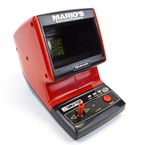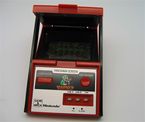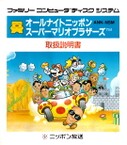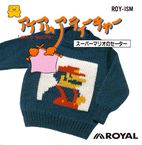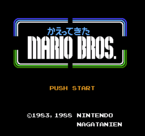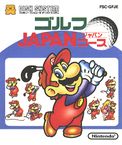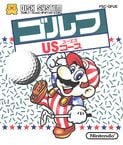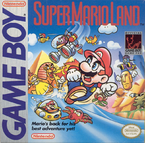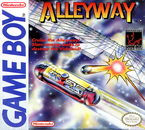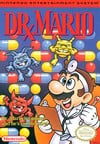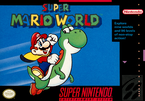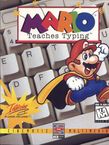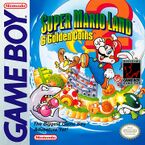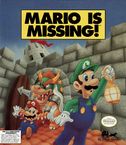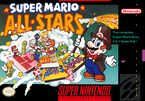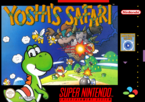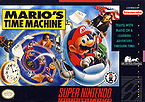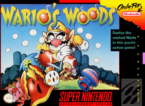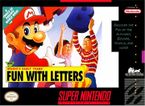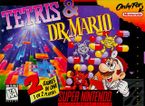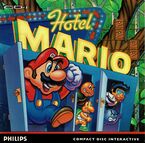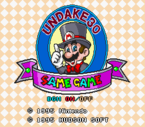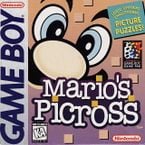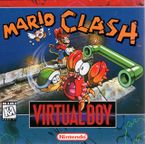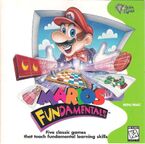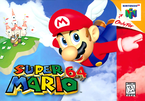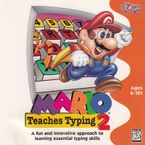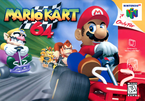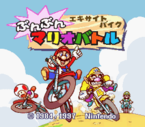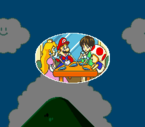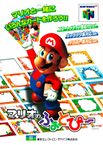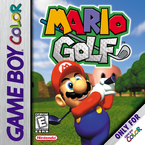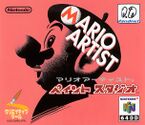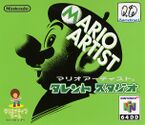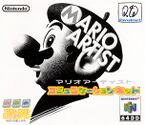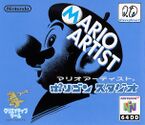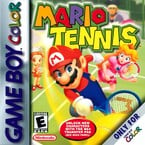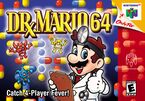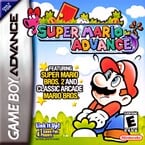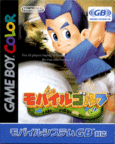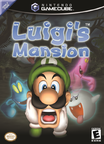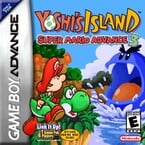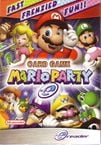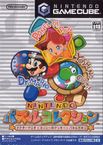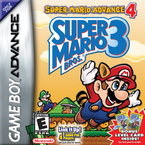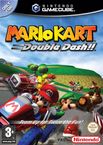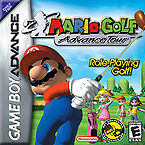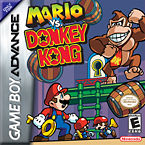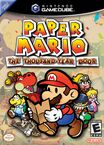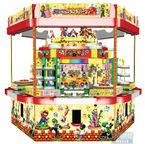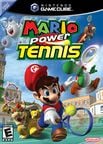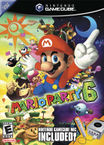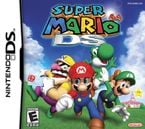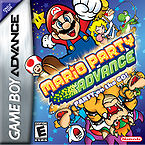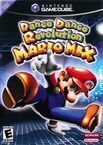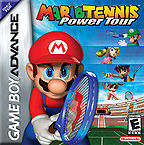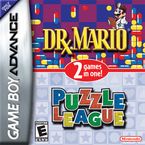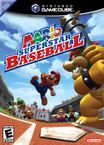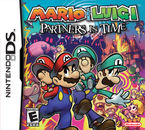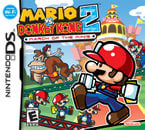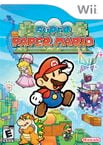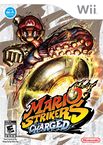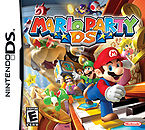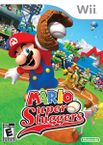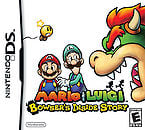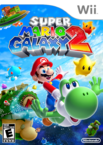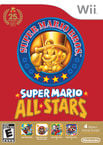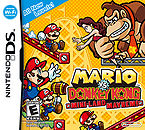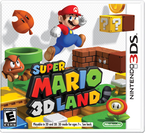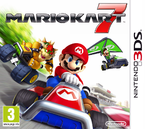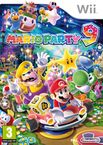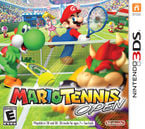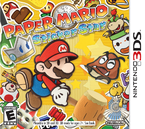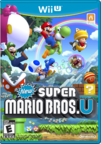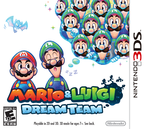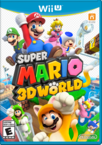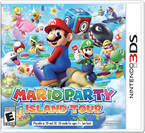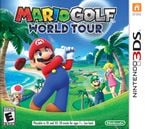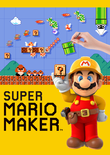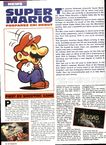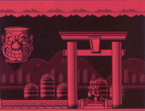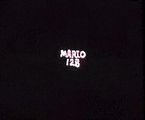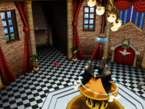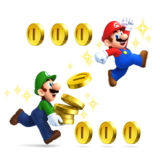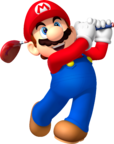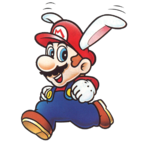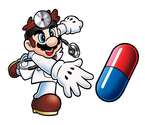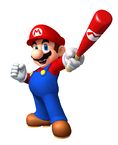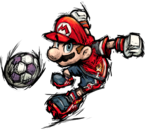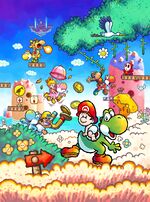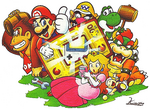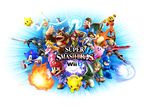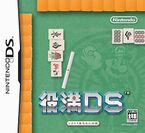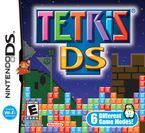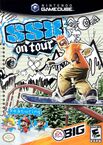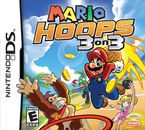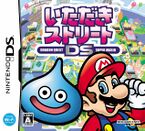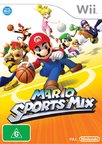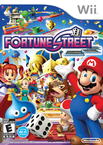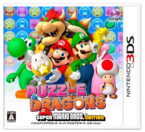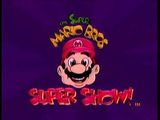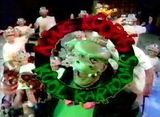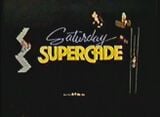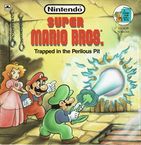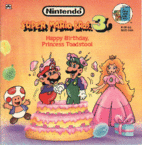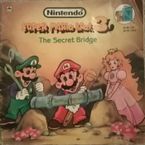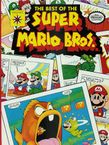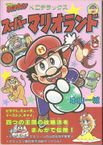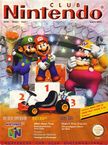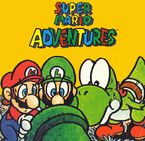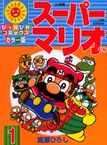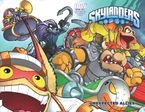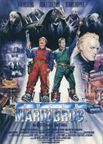Mario (series)
This article is under construction. Therefore, please excuse its informal appearance while it is being worked on. We hope to have it completed as soon as possible.
Template:Articleabout Template:Series-infobox
The Mario franchise is a media franchise consisting of video games published and produced by the Japanese company Nintendo. The title character is a fictional Italian-American plumber who serves as the hero of a realm called the Mushroom Kingdom. The franchise was created by game designer Shigeru Miyamoto and its first installment was the arcade game Donkey Kong, released on July 9, 1981. The games are primarily published and/or developed by Nintendo itself, with some games in the franchise being developed by other companies under Nintendo's supervision, such as Hudson Soft, Camelot Software Planning, Intelligent Systems, and AlphaDream. Most Mario games have been released for Nintendo's various video game consoles and handhelds, from the third generation onwards.
The main series in the franchise is the Super Mario series, consisting of platform games that typically involve Mario and his brother Luigi working to save the Mushroom Kingdom and its ruler, Princess Peach, from the villainous Bowser and his Koopa Troop. The two brothers use their trademark jumping ability to help them progress through levels, while also making use of power-ups of various kinds. Mario games of other genres include the Mario Kart racing series, sports games such as Mario Tennis and Mario Golf, role-playing games such as the Paper Mario and Mario & Luigi series, and several educational games. In total, over 200 video games are included in the franchise, which combined have sold over 500 million copies. The franchise has also been licensed into other media, such as television series, comics, children's books, and a critically lampooned feature film. Mario has gained massive critical acclaim and recognition throughout the world, and is the best-selling video game franchise of all time.
Common elements
Plot, themes, and characters
The franchise revolves around the adventures of an extensive cast of recurring characters. The main protagonist of the franchise, the titular Mario, is a fictional Italian-American plumber who is portrayed as the hero of a realm called the Mushroom Kingdom, which he endeavors to defend by traversing his way through stages filled with obstacles and enemies. His arch-nemesis is Bowser, the king of the Koopas, a race of evil-driven anthropomorphic turtles. Bowser is responsible for most, if not all, of the Mushroom Kingdom's invasions, and almost always appears as the final boss, who constantly and consistently attempts to put an end to Mario and his friends. Mario's younger but taller brother, Luigi, often participates in his adventures alongside him; in early games, he was only playable in the two-player mode. The Mushroom Kingdom's ruler, Princess Peach, is Mario's love interest and recurring damsel in distress; she repeatedly falls victim to Bowser's kidnappings and has to be rescued by Mario, but occasionally serves as a protagonist herself. Another prominent sidekick of Mario's is Yoshi, a dinosaur-like creature who serves as a riding mount to Mario, and has a long tongue which he uses to eat food and enemies; this character became so popular after his debut that he was spun off into his own sub-series. Mario also has a greedy, hot-tempered doppelganger rival named Wario, who has antagonized Mario on various occasions, and also serves as an anti-hero with his own adventures which generally involve money grubbing and treasure hunting. Donkey Kong, a muscular and somewhat dim-witted ape, originally served as Mario's first rival in his arcade debut, but eventually became the main protagonist of his own series. Other significant recurring characters in the franchise include the Toads, inhabitants of the Mushroom Kingdom and servants to Peach, who often support Mario during his adventures; Princess Daisy, the tomboyish ruler of a mysterious kingdom called Sarasaland; Wario's partner in crime Waluigi; Professor Elvin Gadd, an aging scientist and inventor; and Rosalina, a very powerful figure who watches over the cosmos.
Throughout his adventures, Mario faces a wide variety of enemies that make attempts to hinder his progress. The Goombas, mushroom-like creatures that betrayed the Mushroom Kingdom, are extremely weak to the extent that a single stomp is enough to defeat them. Koopa Troopas, foot soldiers of Bowser, retract in their shells if stomped on, after which they can be used to attack other foes. Many different subspecies of Koopa exist, including the aerial Koopa Paratroopas, the projectile-wielding Hammer Bros., the hard-shelled Buzzy Beetles, the cloud-riding Lakitus and their pets the Spinies, the skeletal Dry Bones, and the sorcerous Magikoopas. Other recurring enemies of Mario include the Boos, timid ghosts that cover their faces whenever the hero stares at them; Piranha Plants, man-eating flora that dwell within pipes; Bullet Bills, projectiles that are shot out of cannons called "blasters"; Bob-ombs, anthropomorphic bombs with short tempers leading to inevitable explosions; Chain Chomps, tethered ball-and-chain creatures that lunge at Mario when in close proximity; Bloopers, squids that like to corner and close in on their prey; Cheep Cheeps, fish with wing-like fins and the ability to attack above the surface of the water; Thwomps, rectangular rock creatures that flatten whoever passes below them using their own weight; and Lava Bubbles (also known as "Podoboos"), living fireballs that inhabit lava pits and attack by leaping upward out of the lava. Major individualized minions of Bowser include his son Bowser Jr.; a seven-member clan called the Koopalings; Kamek, a high-ranking Magikoopa who often serves as one of Bowser's top acolytes; and Boom Boom, a powerhouse that attacks by flailing his arms.
Locations
The central location of the Mario universe is the Mushroom Kingdom, which Peach rules over and Bowser regularly invades. The kingdom has a diverse landscape that includes forests, deserts, snowlands, beaches, mountains, and plains. When Bowser invades the kingdom and kidnaps Peach, he takes her to his castle, usually situated in a volcanic world, and Mario and his friends have to travel there and defeat some of Bowser's most powerful minions, as well as Bowser himself, in order to get the princess back. Some games have been set in locations other than the Mushroom Kingdom, such as the island where Yoshi and his dinosaur friends live, and Isle Delfino, a large dolphin-shaped tropical resort.
Gameplay mechanics
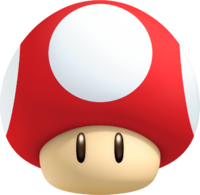
In the main Super Mario series, Mario traverses his way through the games' various levels by defeating enemies, collecting coins, and solving puzzles. Since his earliest games, Mario has been defined by his trademark jumping ability, which he commonly uses to help him progress through the playfield and defeat the majority of his enemies. This ability has seen numerous evolutions throughout the series, including the Spin Jump from Super Mario World; and the Triple Jump, Wall Kick, and Long Jump, all introduced in Super Mario 64. In the 2D platformers, Mario must reach a single-exit objective (marked by a flagpole or other object) within a set time limit to get to the next sequential level; the 3D games' levels, however, are more linear and allow Mario to walk around freely and gather special objects, like Power Stars and Shine Sprites, that allow him to progress further into the game.
Another integral element of Mario franchise gameplay is the use of items, which Mario can use to power himself up. Often these items can be found in special item blocks, labeled with a question mark (?), which alternatively can also yield coins.
Many power-ups in the Mario games are mushrooms. The most iconic of this category of power-ups is the Super Mushroom, which increases Mario's size and allows him to break brick blocks. When hit by an enemy, Mario reverts to his smaller size instead of losing a life. While Mario is already in Super form, most blocks that would contain a Super Mushroom instead offer a more powerful power-up. The Japanese Super Mario Bros. 2 introduced the Poison Mushroom, which behaves more like an enemy, shrinking or killing Mario whenever he comes in direct contact with it. The New Super Mario Bros. series introduced two additional mushroom power-ups: the Mini Mushroom, which shrinks Mario into miniature size, allowing him to access areas he normally cannot; and the Mega Mushroom, which grows Mario into a towering, invulnerable giant who destroys enemies and the environment by running through them.
Certain items exist that grant Mario an extra life. The most recurring and significant is the 1-Up Mushroom, which appears similar to the Super Mushroom but is green instead of red. It is sometimes hidden in invisible item blocks, and in the 3D games, it sometimes appears when Mario walks in a particular area. Although the 1-Up Mushroom is the most common extra life-granting item in the franchise, there are other items that serve the same or a similar function, such as the 3-Up Moon introduced in Super Mario World, which grants three extra lives instead of one.
There are also power-ups taking the form of flowers, which allow Mario to shoot projectiles of various kinds. The first and most significant is the Fire Flower, which turns Mario into his fire form, in which he is able to sling bouncing fireballs at incoming enemies. Mario's fireballs instantly kill most enemies on contact, except for certain enemies which are fire-resistant, like the Buzzy Beetle. Later games introduced alternate variants of this item, such as the Ice Flower, which allows Mario to shoot balls of ice that can also freeze enemies in ice blocks to be used as platforms or projectiles; and the Gold Flower from New Super Mario Bros. 2, which turns Mario into gold and allows him to turn bricks into coins and earn bonus coins for defeating enemies.
Another prominent item in the series is the Super Star (also called the Starman), a flashing anthropomorphic star which grants Mario temporary invincibility, allowing him to kill virtually any enemy upon making contact with it. Some games feature substitutes for this item, like Super Mario 64, where Mario can resist harm using the Metal and Vanish Caps; and Super Mario Galaxy and its sequel, where invincibility is provided by the "Rainbow Star," which also progressively increases Mario's speed, to the point where he becomes almost uncontrollable as his power wears off, and allows him to break through certain objects.
Coins are a common element in Mario game design, traditionally incorporated as puzzles and rewards. Most Super Mario games award the player an extra life once a certain amount of coins are collected, commonly 50 or 100. There are also special variants of Coins, such as Dragon Coins in Super Mario World, Red Coins in Super Mario 64 and a number of games afterwards; and Star Coins in the New Super Mario Bros. games. In Super Mario 64, Sunshine, and the Galaxy games, coins replenish health (and air, when Mario is underwater). In RPGs, Coins can be used to purchase items and other useful things.
One of the Mario franchise's most common modes of transportation is the Warp Pipe, a drain pipe-like structure which comes in a number of different colors (the most common being green). Warp Pipes provide access to secret underground areas that often host mass amounts of Coins, and can also function as platforms that allow Mario to traverse from one area to another; some pipes even launch the hero into the air. Special well-hidden areas in early games, known as "Warp Zones," contain pipes that allow players to skip several levels and even entire worlds at once. Most 3D games in the series feature cannons that allow Mario to progress through levels and reach otherwise inaccessible areas; to use them, he jumps into the barrel, aims himself and is fired at his target.
Video games
1981-1989
| Title, original release and system | Synopsis and Ratings |
|---|---|
| Donkey Kong
|
In 1981, the Mario series officially started with the release of Shigeru Miyamoto's creation - Donkey Kong. Originally released in the arcades, Donkey Kong became a very popular game amongst gamers, eventually spawning many remakes and ports. In 1981, Mario had yet to be called so -- rather, he was called "Jumpman" during that brief era; it was only a few years later that Mario Segale would rename the aforementioned character to "Mario". Mario was also a carpenter in the game and would not be a plumber until Mario Bros. Since then, the name has become very popular among the video game community; he is considered to be one of Nintendo's mascots. Since the release of Donkey Kong in 1981, Mario has appeared in over 200 games, and has been referenced in several more. The object of the game was to control Mario to get to the top of the construction site while also trying to dodge barrels to reach Pauline, who had been kidnapped by Donkey Kong. |
| Template:Releasedate Arcade Machine | (Ratings unavailable) |
| Donkey Kong (Game & Watch)
|
A year after the release of Donkey Kong, Nintendo remade the game on their Game & Watch system while retaining the same name. As in the original game, Mario's girlfriend Pauline has been kidnapped by Donkey Kong. Now, Mario must climb up a construction site while dodging barrels the ape throws at him in order to reach him; he must then use a crane to knock the girder out from under him. This game would later be ported into three future Game & Watch games: Game and Watch Gallery 2, Game & Watch Gallery 4, and Game & Watch Collection; while the Game Boy releases lacked a second screen, all three retained the original gameplay. There were also two game modes: an easy mode and a hard mode. |
| Template:Releasedate Game & Watch | (Ratings unavailable) |
| Mario Bros.
|
Two years later, in 1983, Mario got his own game - using his current name. In the game Mario Bros., Mario and his brother Luigi - who first debuted in this game - were traversing the creature-infested depths of the sewers. This game is Mario's debut as a plumber. Mario and Luigi had to fight such creatures as Fighter Flys, Shellcreepers and Sidesteppers to clear each stage, while also collecting coins during the levels as payment. Mario Bros. is the 1st Mario game with infinite levels (and last.) Since its release, it has been released as a minigame with several other games, as well as being re-released once. It also received a sequel, Mario Clash, in 1995. |
| Template:Releasedate Arcade Machine | (Ratings unavailable) |
| Mario Bros. (Game & Watch)
|
On the same year as the NES game, Mario Bros. for the Game & Watch was released. However, despite the similar names, it bears no resemblance to the arcade game. In this game, Mario and Luigi work for a bottling company and are loading bottles on a truck for delivery. Being on a dual-screen game system that opened up like a book, the game allowed for two players, Mario being on the right and Luigi on the left. This game was later re-released in Game & Watch Gallery 3. |
| Template:Releasedate Game & Watch | (Ratings unavailable) |
| Mario's Cement Factory
|
Another release on Game & Watch, Mario's Cement Factory involves Mario running around a cement factory in order to open hatches to prevent the cement behind them from overflowing; if it does so, the cement will injure a factory worker, and will count as a miss. Mario must also avoid touching the factory floor, which will electrocute him and count as a miss, and three results in a game over. |
| Template:Releasedate Game & Watch | (Ratings unavailable) |
| Mario's Bombs Away
|
Mario's Bombs Away, released on Game & Watch, involves Mario, as a member of the army, transporting bombs from one side of the screen to another while avoiding enemy torches or fires started when Mario's friend carelessly tosses his cigarettes into puddles of oil. When he reaches the other side, Mario can only give a bomb to his friend when his hands are down, and must hand him four more to cause them to blow up on the enemy. As with the previous game, three misses results in a game over. |
| Template:Releasedate Game & Watch | (Ratings unavailable) |
| Golf
|
Before the release of Super Mario Bros., Mario appeared in his first ever sports game: Golf — it was released in 1984. The gameplay is relatively simple: the player must strike the ball with the correct amount of force in order to get a good shot. The more good shots and the player gets, the more points he or she is likely to earn. Golf Mario is stated to be the playable character (even he is not seen in his traditional clothing) but the original version instead claims the golfer name is Ossan. |
| Template:Releasedate NES | (Ratings unavailable) |
| Mario Bros. Special
|
A game developed by Hudson Soft, Mario Bros. Special wasn't a port of the original game, but a complete remake, with new graphics and sounds. Instead of having to defeat every enemy in the level, the game involved trying to get to the top of a level, where the exit to each level is. |
| Template:Releasedate PC88 | (Ratings unavailable) |
| Punch Ball Mario Bros.
|
Punch Ball Mario Bros., also released only in Japan by Hudson Soft, involved basically doing the same thing as in Mario Bros., but also involved using Punch Balls to hit enemies, stunning them, and then they could be kicked away like normal. Another difference between this and the original was that the platform pattern was reversed. |
| Template:Releasedate PC88 | (Ratings unavailable) |
| Wrecking Crew
|
In June of 1985, Nintendo released Wrecking Crew in Japan for the Famicom Disk System, then later that year in other parts of the world for the NES. The concept of the game revolved around Mario (and Luigi, if a second player were to join the game) who were in the middle of a demolition site. While at the site, they had to break down all of the concrete walls with their hammers found in each level. The player would encounter several enemies, none of which could be defeated with the hammer that Mario (or Luigi) would carry. Rather, they would have to trap enemies under steel drums. The game also featured a new character: Foreman Spike, who would occasionally appear to outdo Mario at breaking down the concrete walls, and who could push Mario off of ledges. The game also featured a custom level creator, the first game in the Mario series to ever do so. |
| Template:Releasedate Famicom | (Ratings unavailable) |
| Super Mario Bros.
|
On September 13, 1985, Mario starred in his very first game outside of the arcades. With the release of Super Mario Bros., the NES was an extreme success. Mario, and his brother Luigi, had to set out on a massive adventure across the Mushroom Kingdom to rescue Princess Toadstool and the Mushroom Retainers from the evil King Bowser. After traversing through eight massive worlds, filled with enemies, the brothers eventually reached Bowser's Castle, finally rescuing Princess Toadstool. Super Mario Bros. was the best-selling video game for the NES in 1999,[2] and, until surpassed by Wii Sports in 2009, the best-selling video game of all time. Super Mario Bros. also had a major part in both the takeoff of the NES and the revival of the American video game industry after the crash in 1983. |
| Template:Releasedate NES | (Ratings unavailable) |
| Super Mario Bros. Special
|
Super Mario Bros. Special is the true "lost" game of the series, which was made by Hudson Soft for the PC88 series of Japanese PCs and officially licensed by Nintendo. SMB Special was the very first licensed sequel to Super Mario Bros. to appear, released a few months before Super Mario Bros.: The Lost Levels in 1986. While superficially very similar to the original Super Mario Bros., the game features completely-original levels and lacks a screen-scrolling mechanism. Jumping and running physics also differ from the original, providing a more challenging experience than Super Mario Bros. Due to the PC88's technology being slightly inferior to that of the NES/Famicom, the graphics and audio differ slightly from the original NES game as well, although they are closely emulated, and does not include Luigi or a multiplayer mode. |
| Template:Releasedate PC88 | (Ratings unavailable) |
| Super Mario Bros.: The Lost Levels
|
After the extreme success of Super Mario Bros., Super Mario Bros.: The Lost Levels was released just one year later in Japan. The gameplay and story were almost identical to its predecessor, but it was not released in the United States due to its extreme difficulty.[3] Some gameplay elements were changed slightly, such as Bloopers flying in midair, wind to help the player jump across abysses, and other minor changes. |
| Template:Releasedate NES | (Ratings unavailable) |
| Vs. Super Mario Bros.
|
VS. Super Mario Bros. was a two-player arcade game released in Japan in 1986. The game was mostly the same as the original game; Mario or Luigi went on a quest to save the princess from Bowser and restore order to the Mushroom Kingdom. The game was harder than Super Mario Bros. in that it had less warp zones and more enemies. The game even featured levels from Super Mario Bros.: The Lost Levels. |
| Template:Releasedate Arcade Machine | (Ratings unavailable) |
| All Night Nippon Super Mario Bros.
|
All Night Nippon Super Mario Bros. was an officially licensed hack of Super Mario Bros. Gameplay was the same but many characters such as the Mushroom Retainers were replaced with Japanese celebrities from the radio show All Night Nippon. Other changes were also made for this game, such as World 1 being set during night time and Princess Peach's outfit was changed. The game was only released in Japan. |
| Template:Releasedate Famicom Disk System | (Ratings unavailable) |
| I Am a Teacher: Super Mario Sweater
|
I Am a Teacher: Super Mario Sweater is a 1988 Famicom Disk System game released only in Japan. It was designed by Royal industries Co. Ltd., a Japanese appliance and sewing machine company. The company realized that they could make a lot of money by releasing a sweater-design program, which led to this game. Players could design the sweater they want, and the company would make a real-life version for 2,900 Yen (about $24). |
| Template:Releasedate Famicom Disk System | (Ratings unavailable) |
| Famicom Grand Prix: F-1 Race
|
Famicom Grand Prix: F-1 Race was a game released only in Japan for the Famicom Disk System. The game involved playing as Mario and racing other computer-controlled vehicles to try and win first place; winning a Grand Prix resulted in the player winning money, which could be used to buy cars. The cars also had limited health, which decreased if the player hit walls or other cars and if they drive off-road. Players can also stop for a pit-stop and repair their car, giving them more health and fuel, but it took time away from the race. |
| Template:Releasedate Famicom Disk System | (Ratings unavailable) |
| Kaettekita Mario Bros.
|
Kaettekita Mario Bros. (translated as Return of Mario Bros., but also commonly known as Mario Bros. Returns in English-speaking countries) is a Japanese game for the Famicom Disk System. The game has several modes that can be accessed from the main menu. The "Original Mario Bros." mode plays, for the most part, similarly to the Mario Bros. game that was released to arcades. However, there are several differences: some new levels were added, Mario and Luigi can now change direction in mid-air (much like modern remakes), the graphics and music were improved, high scores can now be saved and advertisements appeared between levels. Some were for upcoming Mario games, such as Super Mario Bros. 3; others were for the Japanese food company Nagatanien, who sponsored this game. There is also a two-player version of this mode, in which both players are active at the same time. |
| Template:Releasedate Famicom Disk System | (Ratings unavailable) |
| Family Computer Golf: Japan Course
|
Family Computer Golf: Japan Course is a golfing game released only in Japan starring Mario and Luigi. The courses in this game were created based on actual Japanese golf courses. The game was compatible with a service called Disk Fax, in which players, using a machine, could send their save data and high scores to Nintendo. Using this service, a contest was held in which the winner received a gold copy of this game, featuring a higher difficulty and an extra course. |
| Template:Releasedate Famicom Disk System | (Ratings unavailable) |
| Family Computer Golf: U.S. Course
|
Released a few months later as a sister title to Japan Course, Family Computer Golf: U.S. Course is a Japan-exclusive golf game. Like with Japan Course, the courses in this game are based on real golf courses in the United States. This game was also compatible with the Disk Fax service, and a contest was held featuring this game as well, with the same prize and the gold disk having the same additional features. |
| Template:Releasedate Famicom Disk System | (Ratings unavailable) |
| Super Mario Bros. (Game & Watch)
|
Two years after the release of Nintendo's first biggest commercial success, the company released a remake of the game on their Game & Watch system. Being a remake of the game, it essentially has the same plot, but with only eight levels; however, after beating every level, they will have to be repeated. Mario will have to go through nine loops, each time with the levels increasing in difficulty. There are also two types of levels: scroll screen levels, in which Mario will have to reach a certain point to advance, and timer screen levels, in which Mario must get through the world in a given amount of time. Additionally, another difference between the original and this remake is that Mario will find Princess Toadstool at the end of every level, without having to fight a boss. |
| Template:Releasedate Game & Watch | (Ratings unavailable) |
| Famicom Grand Prix II: 3D Hot Rally
|
Famicom Grand Prix II: 3D Hot Rally was the Japan-only sequel to Famicom Grand Prix: F-1 Race. Mario and Luigi were two playable characters, and could drive one of three cars: Kattobi, Yonque and Monster. |
| Template:Releasedate Famicom Disk System | (Ratings unavailable) |
| Super Mario Bros. 2
|
Two years later in 1988, Nintendo released yet another Mario game for the NES - Super Mario Bros. 2. Despite the fact that the game's title has "2" in it, it was not the direct sequel to Super Mario Bros. — Super Mario Bros.: The Lost Levels was, however it was not released outside of Japan. In this game, Mario, Luigi, Princess Toadstool, and Toad had to save the dream world of Subcon from the diabolical Wart. After fighting their way through seven strange worlds, they eventually saved Subcon, and Mario woke up from his dream. Super Mario Bros. 2 would eventually be released in Japan as Super Mario USA. |
| Template:Releasedate NES | (Ratings unavailable) |
| Super Mario Bros. 3
|
Another two years had passed by the time the next mainstream Mario game had been released: Super Mario Bros. 3. This was by far, the most expansive Mario game on the NES, as it featured many levels, items, and enemies. Bowser and his seven Koopalings wreaked havoc across the Mushroom World after turning all of the Mushroom Kings into various animals. Mario and Luigi had to traverse through many worlds, castles, seas, forests, and deserts to fix the wrongs the Koopalings had caused. Eventually, the brothers reached Bowser and defeated him, rescuing Princess Toadstool once again. |
| Template:Releasedate NES | (Ratings unavailable) |
| Super Mario Land
|
Mario made the jump to Nintendo's first handheld system in 1989, with the release of Super Mario Land. Selling a total of 18.06 million copies[4], it became the bestselling video game not to be bundled with a system in history for quite some time. In this game, Mario had to traverse across the four worlds of Sarasaland to save the Princess Daisy from the alien Tatanga. With the help of new features such as the Superball, Marine Pop, and the Sky Pop, Mario was able to stop Tatanga and save Daisy. |
| Template:Releasedate Game Boy | (Ratings unavailable) |
| Alleyway
|
Alleyway was a game made in a classic breakout-style. Its gameplay involved using the paddle, which is driven by Mario, to hit a ball to destroy the blocks above it. Every fourth round in the game a sprite from Super Mario Bros. would appear. |
| Template:Releasedate Game Boy | (Ratings unavailable) |
1990-1999
| Title, Original Release, and System | Synopsis and Ratings |
|---|---|
| Dr. Mario
|
Dr. Mario was the first game in the Dr. Mario series; it was released for the NES in 1990. The game brought the basic concept of the series to the players' attention immediately, as they would start the game off having to reorganize falling Megavitamins in order to eradicate viruses from the screen. Once all viruses have been eliminated, the player would move on to the next level. As the game progressed, each level rose in difficulty, providing more viruses for the player to eliminate and less space to maneuver the Megavitamins in. Dr. Mario was ported and remade many times after its original release. |
| Template:Releasedate NES | (Ratings unavailable) |
| Super Mario World
|
One year after the release of Super Mario Bros. 3, Super Mario World had been released on a whole new home console — the Super Nintendo. It was with this game that the Mario series had been upgraded from 8-bit to 16-bit graphics. Though the games' graphics would later be revolutionized once again, this was indeed a huge step at the time. During the story of Super Mario World, while Mario, Luigi, and Princess Toadstool were vacationing in Dinosaur Land, Bowser and his seven Koopalings once again kidnapped the Princess. With the help of the Yoshis and Dolphins, the brothers traversed across the vast area of Dinosaur Land. As they made their way to Princess Toadstool, they thwarted each Koopaling who stood in their way until they reached Bowser. Once again, Bowser had been defeated and Princess Toadstool had been rescued. |
| Template:Releasedate SNES | Gamespot - 8.5: Great |
| Mario Roulette
|
Mario Roulette was a Japan-only arcade game released in 1991. Mario, Peach, Bowser, and Yoshi were the main characters. The graphics were mostly from Super Mario World. |
| Template:Releasedate Arcade Machine | (Ratings unavailable) |
| Mario the Juggler
|
Years after the release of the previous Mario-based Game & Watch game, Nintendo released Mario the Juggler, a remake of the first Game & Watch game Ball and the final Game & Watch unit created. The game stars Mario, in which he is attempting to juggle various items and objects from the Mario series. Over time, the number of objects needed to be juggled will increase from one to three, and will fall faster with time. As with all Game & Watch games, three misses is a game over. |
| Template:Releasedate Game & Watch | (Ratings unavailable) |
| Mario Teaches Typing
|
In 1991, Mario Teaches Typing was released. This game was the first Mario edutainment game released. The game used several Mario-related elements to teach young kids how to type. To advance through the game itself, the player must type the letters or words on the screen. By doing so correctly, the player can cause several actions to occur. Another gameplay mode allowed the player to type the first letter of a word. |
| Template:Releasedate MS-DOS | (Ratings unavailable) |
| NES Open Tournament Golf
|
NES Open Tournament Golf was a golf-oriented game that featured Mario characters. The game doesn't take place in the Mushroom Kingdom, instead taking place in three real world locations: America, Japan, and the United Kingdom. |
| Template:Releasedate NES | (Ratings unavailable) |
| Super Mario Bros. & Friends: When I Grow Up
|
Super Mario Bros. & Friends: When I Grow Up is a DOS computer game featuring Mario and friends released in 1992. It is an Electric Crayon game and was published by Merit Software. The game is essentially a coloring book on the computer. A few pages have animated sequences. Career themed pages include Policeman, Attorney/Judge, Chef/Waiter, Business Executive, Ballet Dancer, and Homemaker. Characters in the game include Mario, Luigi, Peach, Toads, and Bowser, who is depicted in both his game and DIC cartoons appearances. Link makes a cameo. |
| Template:Releasedate MS-DOS | (Ratings unavailable) |
| Super Mario Bros. Print World
|
Super Mario Bros. Print World is a printing game for the MS-DOS, IBM Tandy and Apple II. It featured figures from Super Mario Bros. 3. |
| Template:Releasedate | (Ratings unavailable) |
| Mario Paint
|
Released on the SNES in 1992, Mario Paint was highly interactive, even utilizing the SNES Mouse. The game had a series of four sequels on the failed N64 add-on, the Nintendo 64DD, known as Mario Artist. The game's title screen was interactive, as each letter of the words 'Mario Paint' would cause a different effect on the title screen. In Art Mode, the player could draw several different creations on a canvas displayed on-screen; these drawings would have elements that were highly influenced from Super Mario World. The game also featured the ability to make Stamps, which were a type of sprite that the player could create in a separate game mode. In addition, the player could create their own music samples using the game's Music Mode. |
| Template:Releasedate SNES | (Ratings unavailable) |
| Super Mario Kart
|
Two decades ago, in 1992, the Mario Kart series had begun with the release of Super Mario Kart. It was one of the first games ever to be made that was 2-dimensional with 3-dimensional renderings. The game featured eight playable characters: Mario, Luigi, Princess Toadstool, Yoshi, Toad, Bowser, Donkey Kong Jr., and Koopa Troopa. Though the player could not pick from a selection of karts, each character was pre-assigned with a kart, each with a different weight, speed, and acceleration. This game was also heavily influenced by Super Mario World, as many of the racecourses took place somewhere within the borders of Dinosaur Land; the game also featured the Cape Feather, which was found in Super Mario World. |
| Template:Releasedate SNES | (Ratings unavailable) |
| Super Mario Land 2: 6 Golden Coins
|
Three years later, Mario reappeared on the Game Boy with the release of Super Mario Land 2: 6 Golden Coins. It was less popular than its predecessor, but not by a lot.[5], Super Mario Land. This story picked up right where the last one left off. After rescuing Princess Daisy, Mario returned to his castle, only to find that it had been taken over by his old nemesis, Wario. Mario must collect six golden coins scattered across Mario Land in order to regain access to his castle and defeat Wario. |
| Template:Releasedate Game Boy | (Ratings unavailable) |
| Mario is Missing!
|
In 1992, Nintendo added to the list of Mario edutainment games by releasing Mario is Missing!. The game was originally released for MS-DOS, but was later released on the NES, SNES, and then released again on the PC. The game was also the first to feature Luigi as the main playable protagonist. The story revolves around Bowser, who has kidnapped Mario and taken him to his fortress in Antarctica. Bowser then plans to steal several shipments of hair dryers in order to melt the icy continent and flood the world. Luigi must then travel through several locations on Earth in order to retrieve several artifacts to help him rescue his brother. The game was designed to be simple in battle, as the enemies and bosses found throughout the game could not harm the player. |
| Template:Releasedate MS-DOS | (Ratings unavailable) |
| Mario Unkurukai
|
Mario Unkurukai was a Japan-only arcade game based on dancing. The game was mostly meant for small children. The game is almost the same as the later game Dance Dance Revolution: Mario Mix, except for the two neutral spaces and no two-player mode. |
| Template:Releasedate Arcade Machine | (Ratings unavailable) |
| Super Mario All-Stars
|
In 1993, a compilation of NES Super Mario Bros. games had been released. The game was titled Super Mario All-Stars. The game contained Super Mario Bros., Super Mario Bros.: The Lost Levels (the first U.S. release of that game), Super Mario Bros. 2, and Super Mario Bros. 3. The games featured updated graphics to fit the 16-bit memory of the Super Nintendo. Not many other changes had been made to the games. One year later, in 1994, a second installment called Super Mario All-Stars + Super Mario World had been released. As its name implies, it has all the previously mentioned NES games as well as the addition of Super Mario World. A Wii remake of the original compilation game called Super Mario All-Stars Limited Edition was released in 2010. |
| Template:Releasedate SNES | (Ratings unavailable) |
| Yoshi's Safari
|
In 1993, Nintendo released Yoshi's Safari for the SNES. The game carried over many aspects of Super Mario World, featuring many of the same bosses and enemies (such as Chargin' Chucks), and having Mario ride Yoshi throughout the game. Yoshi's Safari is notable for being the only shooter in the Mario series, utilizing the Super Scope to facilitate gameplay. The story revolved around Mario and Yoshi traveling through the vast realms of Jewelry Land. Their mission was to save King Fret and his son, Prince Pine, from the diabolical Koopalings who were terrorizing the land. |
| Template:Releasedate SNES | (Ratings unavailable) |
| Mario & Wario
|
Mario & Wario is a puzzle game only released in Japan, on the Super Famicom in 1993. The game featured three different modes of difficulty and ten levels in which the player had to guide Peach (easy), Mario (intermediate), or Yoshi (hard) to reach Luigi, who is the goal of each level. After Wario drops a random item on the player's head, be it a bucket or a jellyfish, Wanda the fairy must then help guide the player to Luigi in order to advance to the next level. The game was one of very few titles to utilize the SNES Mouse. |
| Template:ReleasedateSuper Famicom | (Ratings unavailable) |
| Mario's Time Machine
|
Mario's Time Machine is yet another edutainment game in the Mario series. It was released in 1993 for NES, SNES, and PC. The game is an attempt to teach children various aspects of world history. As such, Mario must use his time machine to travel throughout various time periods in history, dating back to 80,000,000 B.C., all the way up to 1989 A.D.. Mario must collect artifacts from each period of time he visits in order to progress through the game. Should the player fail at retrieving the artifacts in the wrong order, the ending will show Bowser escaping to Paradise, requiring the player to start the game over completely; however, if the game is completed in an orderly fashion, the player will win the game. This game is also notable for being the first and only game in the Mario series that has Mario speaking in full phrases. |
| Template:Releasedate SNES | (Ratings unavailable) |
| Wario's Woods
|
Wario's Woods is a puzzle game released originally for the SNES in 1993; it was later released for the NES in 1994. The game features Toad as the main protagonist, the only Mario game to ever do so. As Toad was out walking one day, he accidentally runs into a large forest owned by the evil Wario. Wario was sending out many of his monsters to invade the Peaceful Woods. Toad has to regain the serenity of the forest with the help of Birdo and the forest's own Sprites. |
| Template:Releasedate NES | (Ratings unavailable) |
| Mario's Early Years! Fun with Numbers
|
Mario's Early Years! Fun with Numbers was the first game in the Mario's Early Years! series. Released in September 1994, the game was aimed at small children and was meant to teach them the basics of numbers and counting. To clear the game, the player must go through various worlds, represented by islands with different environments, waking up a sleeping Luigi, and doing various number-related activities. |
| Template:Releasedate SNES | (Ratings unavailable) |
| Mario's Early Years! Fun with Letters
|
Mario's Early Years! Fun with Letters was released in October 1994, as the second game in the Mario's Early Years series. The game's purpose was to teach children the basics of the English alphabet and how to spell words. The game, like the others, involved players going to different words, each one teaching them different subjects involving the alphabet. The player does this by clicking on objects to interact with them. The player can go down one of two pipes; the first will allow the player to experiment freely, and the other will allow the player to awaken a sleeping Luigi, who will watch the player and compliment him as they play through to complete the area. |
| Template:Releasedate SNES | (Ratings unavailable) |
| Mario's Early Years! Preschool Fun
|
Mario's Early Years! Preschool Fun was the third and final game in the Mario's Early Years series, released in November 1994. The game once again involved sending Mario to different islands that taught the player various subjects that pertained to real-world education. |
| Template:Releasedate SNES | (Ratings unavailable) |
| Tetris & Dr. Mario
|
As the name states, Tetris & Dr. Mario is a game released on the SNES as a two-in-one game featuring a remade version of both Tetris and Dr. Mario. While the core games remain the same, some additions are made for this release. In Dr. Mario, the player has the option of facing a computer on one of three difficulties. There is also a "Mixed Match" game, in which both players compete to beat Tetris mode B, a round of Dr. Mario, and Tetris mode A consecutively. |
| Template:Releasedate SNES | (Ratings unavailable) |
| Hotel Mario
|
In 1994, Hotel Mario was released for the Philips CD-i, and was developed by Philips Media. The game was rather obscure and received very little attention due to the lack of interest in the Philips CD-i. The plot deals with Bowser and his seven children, the Koopalings, who have once again taken over the Mushroom Kingdom; this time, they built a series of hotels, of which, one is hiding Princess Peach. Once Mario and Luigi become aware of this, they set out on a mission to stop Bowser and his children once more and rescue the Princess. The main goal of each stage is to close all of the doors on each floor in order to progress to the next stage or location. However, enemies commonly interfere with the player's goal, thus reopening the doors, requiring them to be closed once more. The name of each hotel is a portmanteau on a Real World hotel, such as the Ritz Carlton hotel. |
| Template:Releasedate Philips CD-i | (Ratings unavailable) |
| Undake30 Same Game
|
UNDAKE30 Same Game Taisakusen Mario Version was a puzzle game that was released in 1995 in Japan. The game could be controlled with a standard joypad or the Super Famicom Mouse and was similar to the card game Monte Carlo. The game centers around a large playing field composed of a random arrangement of Mario Heads, Coins, Yoshi Eggs, Fire Flowers, and Super Mushrooms. If two or more icons are connected, the player can move the cursor and click to make all the connected icons disappear. Now the icons above fall down and the Player can clear even more icons. Also, there is an undo move that allows the Player to take back the last move, and move back as far as wanted. Once the entire grid is clear, the game ends. The game was developed by Hudson Soft. |
| Template:Releasedate Super Famicom | (Ratings unavailable) |
| Satella-Q
|
Satella-Q is a series of quiz game events released exclusively for Japan for the Satellaview (an add-on for the Super Famicom) in 1995. Within the game, Toad was featured as the main and primary character as he guided the players through the number of quizzes and minigames that were available. Each installment of the game series was divided into episodes and each was released at different times during the same year of the game's release. At the moment, it is also the longest-running of the Satellaview broadcasts to this point. |
| Template:Releasedate Satellaview for the Super Famicom | (Ratings unavailable) |
| Mario's Picross
|
In 1995, Nintendo released Mario's Picross for the Game Boy. Mario's Picross was a puzzle game that spawned a sub-series containing two additional games: Picross 2 and Super Mario Picross. The game featured a paint-by-numbers puzzle system, in which there was a 100-square screen for the player to maneuver around. Once the puzzle was completed, the player would advance to the next one, which would increase in difficulty somewhat. A total of 192 puzzles could be found in the game, found throughout three different modes: Easy Picross, Kinoko, and Star — each of which contained 64 puzzles. There was also a time-trial mode, which contained 64 puzzles, (that were previously beaten), that would appear at random. |
| Template:Releasedate Game Boy | (Ratings unavailable) |
| Mario's Tennis
|
In 1995, the first installment to the Mario Tennis series was released —Mario's Tennis. It inspired the creation of several more games in the series, (the next being Mario Tennis for the Nintendo 64). The game had seven playable characters, all of which were featured in Super Mario Kart, with the exception of Bowser who did not appear in this game. |
| Template:Releasedate Virtual Boy | (Ratings unavailable) |
| Mario's Super Picross
|
The Japan-only sequel to Mario's Picross, Mario's Super Picross wasn't released in the west due to the poor reception the original received. The game was mostly the same as the original; the only real difference was that Wario was put into the game. |
| Template:Releasedate Super Famicom | (Ratings unavailable) |
| Mario Clash
|
Mario Clash is an obscure Mario Bros. remake for Virtual Boy. In the game, the player must use Koopa Shells to hit enemies and knock them out of platforms, so they can progress. New enemies not present in Mario Bros. appeared in this game, like Thornys, Lobbs and Snakes. |
| Template:Releasedate Virtual Boy | (Ratings unavailable) |
| Mario's Game Gallery
|
Mario's Game Gallery was an obscure Mario video game for young children released in 1995. Children could play games like "Go Fish", "Checkers", "Backgammon", "Dominoes", or "Yahtzee". Depending on the game, the player either plays against Mario or Bowser. This is the first Mario game in which Charles Martinet provided Mario's voice, not to be confused with Mario Teaches Typing. In 1998, the game was re-released under the name Mario's FUNdamentals. |
| Template:Releasedate MS-DOS | (Ratings unavailable) |
| BS Super Mario USA
File:BS SMUSA Mario & Friends.png |
The pseudo-sequel to Super Mario USA (Super Mario Bros. 2), BS Super Mario USA was released as four installments, and each one involved the player heading into each world to collect a gold Mario statue and defeat the bosses until finally reaching and defeating Wart. Each level could be replayed until the clock reached 50 minutes. As the player progressed, St. Giga's Satellite radio would stream an audio drama to tell the story. After the events of Super Mario Bros. 2, the King of Subcon had golden Mario statues put up all around Subcon, to thank him and his friends for their deeds. However, three Birdos, Mouser, Tryclyde, Fryguy and Clawgrip have stolen them, and now Mario must get them back and defeat Wart again. |
| Template:Releasedate Satellaview | (Ratings unavailable) |
| Super Mario RPG: Legend of the Seven Stars
|
The first Mario RPG to be made was one of the last Super Nintendo games to be released — Super Mario RPG: Legend of the Seven Stars. To many, it was a success, as it received great reviews amongst players.[6] This Mario game also introduced the turn-based battle system to the series. HP, Speed, Attack, Defense, Magic Attack, and Magic Defense were all features that Mario, his partners, and enemies all carried. In the story, Princess Toadstool was kidnapped once again by King Bowser; Mario set off on a brief adventure to rescue her. After battling Bowser, Mario did not get the chance to fully rescue the princess. A large sword fell from the sky and plummeted straight into Bowser's Castle, destroying the Star Road, while sending the three into different directions. After Mario wakes up back in the Mushroom Kingdom, he sets out on an adventure to find out what happened all the while still having to rescue Princess Toadstool. Along his journey, Mario meets characters such as Mallow and Geno, all of whom join him in hopes of defeating Smithy, the cause of the Mushroom Kingdom's current state. This is the first game in which Bowser allied with Mario, and in which Bowser and Princess Toadstool were playable characters. |
| Template:Releasedate SNES | (Ratings unavailable) |
| Super Mario 64
|
Not long after the release of Super Mario RPG: Legend of the Seven Stars, Nintendo released a new system and a new game — Super Mario 64. The game was a success. It was the first fully 3-Dimensional Mario game to ever be made, thus revolutionizing the appearance of Mario games to date. The game sold over eleven million copies by 2007.[7] Because the game had such amazing success, people began to create rumors of glitches[8] and unlockables in the game. Perhaps one of the most notable rumors was that Luigi was a playable character in the game.[9] This was also the second game to call Princess Peach by her current name (with Yoshi's Safari being the first). In the game, Mario was invited to Princess Peach's Castle to eat a cake she had baked. However, when Mario arrived at her castle, he had discovered that Bowser had taken it over and had stolen almost all of the castle's Power Stars— there were some which he did not know existed. As Mario traversed through fifteen different painting worlds, he eventually recovered enough Power Stars to battle Bowser and take back the castle, freeing Peach from her stained-glass prison. |
| Template:Releasedate Nintendo 64 | IGN - 9.8: Amazing• Gamespot - 9.4: Superb |
| Picross 2
|
Picross 2 was one of the two Japan-only sequels to Mario's Picross, the other being Mario's Super Picross. The game was, like the other sequel, mostly the same as the original. During gameplay, the player could be given hints on how to create specific images. Mario and Wario, who are apparently the two playable characters, both had different puzzles to be solved. |
| Template:Releasedate Game Boy | (ratings unavailable) |
| Mario Teaches Typing 2
|
Mario Teaches Typing 2 was released for the computer in 1996, as the sequel to Mario Teaches Typing. The game featured several changes and improvements from the first game. In the game, Mario and Luigi are walking near Bowser's Castle when a typewriter suddenly appears in front of them. To their surprise, it then begins to type on its own, producing a message that says to type the magic words to destroy Bowser's Castle. However, he must type it correctly, or risk the typewriter self-destructing. Mario tries to type the magic words, but his horrible typing cause the typewriter to self-destruct. Mario and Luigi must now recollect the three pieces to the machine to destroy Bowser's Castle. |
| Template:Releasedate MS-DOS | (ratings unavailable) |
| Mario Kart 64
|
Mario Kart 64 was released as the second installment in the Mario Kart series, and was the first to use 3-D graphics. This game also included division of characters by weight classes. Donkey Kong Jr. and Koopa Troopa were taken out of this game, but two new characters were added: Donkey Kong and Wario, both in the heavy class. This game also introduced a four-player Vs. mode. The game involves each character racing each other to get first place, using items attack the drivers ahead of or behind them. |
| Template:ReleasedateNintendo 64 | IGN - 8.1: Great • Gamespot - 6.4: Fair |
| Excitebike: Bun Bun Mario Battle Stadium
|
Excitebike: Bun Bun Mario Battle Stadium is an Super Famicom racing game released in 1997. It is an obscure remake of the NES title, Excitebike. In this game, all human bikers were replaced with Mario characters. The game was somewhat based off of the Mario Kart series. The characters were Mario, Luigi, Yoshi, Toad, Wario and Princess Peach. The players could download more parts of the game via Satellaview. |
| Template:Releasedate Super Famicom | (Ratings unavailable) |
| BS Super Mario Collection
|
A remake of Super Mario Collection, (Super Mario All-Stars in North America) BS Super Mario Collection is a game for the Super Famicom add-on Satellaview. Like with BS Super Mario USA, as the player progressed through the game, voice acting and music would be streamed to the system using the Satellaview's Soundlink capabilities. |
| Template:Releasedate Super Famicom | (Ratings unavailable) |
| Wrecking Crew '98
|
In 1998, Wrecking Crew '98, the Japan-only sequel to Wrecking Crew was released. The game had similar mechanics to that of the previous game, as the player had to line up panels in a color-coded manner in order to get rid of them; there was also the option to smash them with a hammer. The game also featured the ability to rain a large amount of panels on the opponent, causing them to have more difficulty clearing the stage. The story tells that Mario, on his way home, discovers Bowser on a campaign to build several high-rises in the Mushroom Kingdom, which are destroying the plant life of the area. As Mario attempts to trump Bowser's plot, he must fight his old nemesis, Foreman Spike, along with other villains such as Eggplant Man. |
| Template:Releasedate Super Famicom | (Ratings unavailable) |
| Mario no Photopi
|
Mario no Photopi is a creativity game released for the Nintendo 64 in 1998 only in Japan. The game's cartridge has two slots for SmartMedia cards in the top, allowing importing digital photos and other images and for transfer between the cards. The pictures can be edited and decorated with font, artwork from the Mario series, borders and other graphics. |
| Template:Releasedate Nintendo 64 | (Ratings unavailable) |
| Mario Party
|
In 1999, Nintendo released the first Mario Party game to ever be made — Mario Party. The game was a whole new aspect on multi-player capabilities in the Mario series; most games up until now mainly featured a 2-player versus mode, with the exceptions of a few sports spin-offs. The game mechanics worked near-identically to that of a board game: players would rove around the board, moving from space to space, and hitting a Dice Block in order to move said spaces. The players could earn Coins by playing and winning minigames; with a certain amount of coins, the players could buy Stars. Despite the fact that this was a party game, it also had a single-player mode, in which the player would play against CPUs. There were six playable characters in the game: Mario, Luigi, Peach, Donkey Kong, Yoshi, and Wario. Each character had one board modeled after them, in addition to two other boards in the game — one dedicated to the game's antagonist, Bowser, and the other unlockable after collection one-hundred Stars. |
| Template:Releasedate Nintendo 64 | IGN - 7.9: Good • Gamespot - 7.2: Good |
| Super Mario Bros. Deluxe
|
In that same year, Nintendo released another hit, Super Mario Bros. Deluxe. It sold a total of 2.8 million copies in the United States alone.[10] The game was one of the highest rated games according to Gamespot and IGN. This game, though for the Game Boy Color (which didn't have particularly long or large games), had many features and unlockables. It featured two games in one - Super Mario Bros. and The Lost Levels. This was only the second time that The Lost Levels had been released in the United States. There were also many unlockables such as You vs. Boo, a Yoshi Egg Finder, a Calendar, a Photo Album and much more. A multiplayer mode was also available, which was very similar to the You vs. Boo mode. |
| Template:Releasedate Game Boy Color | IGN - 10: Masterful • Gamespot - 9.9: Superb |
| Mario Golf (Nintendo 64)
|
Considered by many to be the first Mario modern-sports game, and the first installment in the Mario Golf series, Mario Golf combined the classic mechanics of golf with various Mario-related elements. The game is compatible with the Game Boy Color-version of the game, allowing one to transfer their GBC character to the N64 version, and characters from this game can be sent over to the GBC game. |
| Template:Releasedate Nintendo 64 | IGN - 8.3: Great • Gamespot - 8.7: Great |
| Mario Golf (Game Boy Color)
|
Released only months after Mario Golf on the Nintendo 64, Mario Golf on the Game Boy Color had many similarities to the original, while also having several differences. A main difference was that this game was similar to an RPG. Players had more control over their character, could explore the area, interact with characters, and level up. The game was compatible with the Mario Golf for Nintendo 64; by linking the GBC with the N64, one could transfer their character to the Nintendo 64 Mario Golf, and characters only in the N64 game could be transferred to the GBC game. |
| Template:Releasedate Game Boy Color | IGN - 10: Masterpiece • Gamespot - 7.2: Good |
| Mario Artist: Paint Studio
|
Released for the failed N64DD only in Japan, Mario Artist: Paint Studio played mostly the same as Mario Paint, in which the player used different painting tools to create drawings. The game also allowed the player to view and manipulate images of famous Nintendo characters. Using the Game Boy Camera or video tape with the Nintendo 64 Capture Cartridge, images could be imported. It is also possible to create a short, 35-frame animation. The player can also play minigames and explore three 3D worlds and take pictures of the creatures inhabiting it. |
| Template:Releasedate N64DD | (ratings unavailable) |
| Mario Party 2
|
The Mario Party series continued in late 1999 when Nintendo released Mario Party 2 on Nintendo 64, the sequel to the original Mario Party. The game re-used most of the mechanics of the original: players went around a board, hitting dice blocks, to reach the Star Space and collect it. The story, however, is different; one day, the characters decide to create their own world, which was named Mario Land. However, they soon begin to argue over a good name for the world, and, while this is going on, Bowser invades the new world, taking an area for himself. Now the characters must go through the world, to stop Bowser and take back their world. |
| Template:Releasedate Nintendo 64 | IGN - 7.9: Good • Gamespot - 7.8: Good |
2000-2009
| Title, Original Release, and System | Synopsis and Ratings |
|---|---|
| Mario Artist: Talent Studio
|
Mario Artist: Talent Studio was one of the few games released for the N64DD, as a part of the Mario Artist series. The primary feature of this game allowed the player to create characters and insert them into movies and animations, and they could also be imported into the other Mario Artist games. Images from cameras and videos can also be imported as 3-dimensional models, and then animated. Movies could also be created by linking a video camera to the Nintendo 64 Capture Cartridge. |
| Template:Releasedate N64DD | (ratings unavailable) |
| Mario Artist: Communication Kit
|
Mario Artist: Communication Kit was released in Japan about one month after the previous game. The game mostly acted as an accessory for the others, allowing the player to upload his creations online using a RandNetDD internet service, send creations from one game to the other, and even allowed them to ask Nintendo for a printout of their images. A secret option in the menu let the player download pre-made content for the other games. |
| Template:Releasedate N64DD | (ratings unavailable) |
| Paper Mario
|
After another two years had passed, Nintendo released another Mario game — Paper Mario. It was the first Mario role-playing game since the release of Super Mario RPG for the Super Nintendo. Paper Mario brought up a whole new concept for graphics in the Mario series, as everything in the game was made to look as if it were made out of paper. Once again, Mario had to set out on a long mission to save Princess Peach from Bowser. As Mario set out on his adventure, he met citizens of various villages that wanted to assist him on his journey, the first of which was Goombario. At the end of each chapter, Mario and his partners would fight a boss, eventually leading to the freedom of a Star Spirit. When Mario and his partners had freed all of the Star Spirits, they were prepared to fight Bowser. After an epic two-part battle with Bowser, Mario eventually rescued Princess Peach from her current fate. Paper Mario is the only Mario role-playing game to date in which Bowser acts as the main antagonist; in all other Mario role-playing games, Bowser has either taken the role of an ally, or as a somewhat minor antagonist. Paper Mario has inspired four sequels to date — Paper Mario: The Thousand-Year Door, Super Paper Mario, and Paper Mario: Sticker Star on the Nintendo 3DS. |
| Template:ReleasedateNintendo 64 | IGN - 9.0: Outstanding • Gamespot - 9.5: Superb |
| Mario Artist: Polygon Studio
|
Mario Artist: Polygon Studio was the final released game for the Mario Artist series. The game let the player create, render, color, and then texture 3D models. They could also import these models into the other games. These models can also be used in various microgames. |
| Template:Releasedate N64DD | (ratings unavailable) |
| Mario Tennis (Nintendo 64)
|
The first sports-oriented Mario game, Mario Tennis was released on the Nintendo 64 in 2000. The game not only introduces Waluigi into the Mario series, but it also re-introduces Daisy and Birdo. Mario Tennis also has several game modes: Exhibition, tournament, special tournament, ring shot, Bowser stage, and the Piranha challenge. This game is also compatible with its Game Boy Color counterpart, able to transfer information between the two. The game is compatible with the N64 version, allowing players to transfer info from the two games. |
| Template:Releasedate Nintendo 64 | IGN - 9.0: Amazing • Gamespot - 8.2: Great |
| Mario Tennis (Game Boy Color)
|
Months after the release of Mario Tennis on the Nintendo 64, another version was released for the Game Boy Color. The game features four modes: the Mario tour (the game's story mode), exhibition, and linked play, which requires two Game Boys linked together; and a mini-game mode. The game's story involves playing as Alex or Nina, who are trying to rise through the ranks at the Royal Academy, a tennis school. |
| Template:Releasedate Game Boy Color | IGN - 9.0: Amazing • Gamespot - 8.0: Great |
| Mario Party 3
|
In 2000, Nintendo released Mario Party 3, the third installment in the Mario Party series. The game once again incorporates the same game mechanics from the previous installments: go around a board to collect Stars, and the player with the most wins. However, there is still an original story mode. One day, Mario and friends are relaxing when the Millennium Star arrives and puts them in a toy box. Now, to earn the respect of the Millennium Star and become the Superstar, they have to collect the seven Star Stamps. |
| Template:Releasedate Nintendo 64 | IGN - 6.4: Okay • Gamespot - 7.5: Good |
| Dr. Mario 64
|
Dr. Mario 64 was the third installment in the Dr. Mario series. The game was mostly the same as the original; players had to drop pills into a jar to kill the germs. However, this time, the game had a story mode. In it, the time is flu season, and Dr. Mario wishes to use Megavitamins to cure everyone. However, Wario wishes to steal these and become rich, but Mad Scienstein beats him to it. Now Dr. Mario must go after Mad Scienstein to get his vitamins back. |
| Template:Releasedate Nintendo 64 | IGN - 5.0: Mediocre • Gamespot - 7.0: Good |
| Super Mario Advance
|
Super Mario Advance was released onto the Game Boy Advance as a remake of Super Mario Bros. 2, based mostly off of the Super Mario All-Stars version of the game. One of the main differences between this and the original was the inclusion of voices for Mario and friends and bosses. There is also a point system, along with new Ace Coins; collecting all five earns the player a 1-up, along with a star over the level on the level selection screen. An option to play the classic Mario Bros. was included as well. The game's plot remains the same: the dream land Subcon is taken over by Wart, and Mario and friends must save the land from his reign. |
| Template:Releasedate Game Boy Advance | IGN - 8.0: Great • Gamespot - 8.2: Great |
| Mobile Golf
|
Mobile Golf was released only in Japan as part of the Mario Golf series. The game featured similar gameplay to Mario Golf on the Game Boy Color. Several characters from the GBC game could be unlocked as well. |
| Template:Releasedate Game Boy Color | (ratings unavailable) |
| Mario Kart: Super Circuit
|
Mario Kart: Super Circuit (known as Mario Kart Advance in Japan) was the third Mario Kart game in the series, released onto the Game Boy Advance. The game mostly involved the same gaming elements as the previous installments, but also contained additions. One new feature in this game is the inclusion of five cups: the four original cups (Mushroom, Flower, Star, and Special), and the new Lightning Cup. The game also included a sort of Retro Grand Prix, which was basically all the original Super Mario Kart courses; this marks the first time retro courses have been in a Mario Kart game. |
| Template:Releasedate Game Boy Advance | IGN - 9.5: Amazing • Gamespot - 8.2: Great |
| Mario Family
|
Mario Family was the first sewing machine to be operated by a Game Boy Color. The sewing machine used was the JN-100. The game worked by receiving instructions from the Game Boy Color so the player could then embroider the designs. The designs were all Mario-themed and came from games such as Super Mario Bros, Super Mario Land and Super Mario World. The game was only released in Japan. |
| Template:Releasedate Game Boy Color | (ratings unavailable) |
| Luigi's Mansion
|
In late 2001, Nintendo released the GameCube, and one of the launch titles was the Luigi's Mansion. The game was the second ever Mario game to star Luigi as the main protagonist in the game, after Mario is Missing; all other games prior to this one had Luigi portrayed as a sidekick or some sort, or off on his own mission. At the beginning of the game, Luigi is shown walking up to the large mansion that he won in a contest. Inside the mansion, Luigi encounters a few unfriendly beings, only to be saved by Professor Elvin Gadd. The Professor tells Luigi that the mansion is haunted with hundreds of ghosts, and sends him in to stop them in hopes of rescuing Mario. As Luigi passes through the various rooms of the house, eliminating ghosts with the Poltergust 3000, he eventually runs across some of Mario items: his hat, his shoe, his glove, and his star. After taking them to a ghostly fortune teller, Luigi discovers that Mario is indeed still alive and is being held captive by the Boos. Thus, Luigi travels forth more, ridding the mansion of any Boos along the way. Eventually, he finds King Boo's lair, finding Mario trapped within a painting frame. Luigi is whisked away to the mansion's roof, where he battles King Boo and its huge Bowser suit. After defeating King Boo, Luigi takes the framed Mario back to E. Gadd's lab, where he is soon thereafter freed. |
| Template:Releasedate GameCube | IGN - 7.0: Decent • Gamespot - 7.9: Good |
| Super Mario World: Super Mario Advance 2
|
Super Mario World: Super Mario Advance 2, the sequel to Super Mario Advance, was released near Christmas as a remake of Super Mario World for the SNES. Several changes were also made to this game; one of them being the ability to switch between playing as Mario or Luigi by pressing |
| Template:Releasedate Game Boy Advance | IGN - 9.3: Amazing • Gamespot - 9.4 |
| Super Mario Sunshine
|
In 2002, Mario was back in action in his own three-dimensional platformer once again. While on his way to a vacation with Princess Peach and her loyal steward, Toadsworth, they discover a large glob of Graffiti in the shape of Mario's head at Delfino Airstrip. Mario then finds an interesting machine, called F.L.U.D.D., that helps him rid the island of Graffiti. After he collects a total of ten Shine Sprites, an impostor bearing a striking resemblance to Mario kidnaps Princess Peach. Mario then must redeem his identity (because of Shadow Mario) by ridding the entire island of Graffiti, all the while having to rescue Princess Peach. Towards the end of his adventure, he discovers that Shadow Mario is actually Bowser Jr. in disguise. After fighting Bowser and his son, Mario rescues Princess Peach, finally allowing them to start their vacation. |
| Template:Releasedate GameCube | IGN - 9.4: Outstanding • Gamespot - 8.0: Great |
| Yoshi's Island: Super Mario Advance 3
|
A remake of Super Mario World 2: Yoshi's Island, Yoshi's Island: Super Mario Advance 3 is the third game in the Super Mario Advance series. Many changes were also made to this game, mostly being level redesigns and additions and graphics changes. Mario Bros., like always, was included as well. The story remains the same: Baby Mario and Baby Luigi are being carried by a stork, until Luigi falls out. Now Mario, allied with the Yoshis, must get Luigi back from Baby Bowser. |
| Template:Releasedate Game Boy Advance | IGN - 9.4: Amazing • Gamespot - 9.2 |
| Mario Party 4
|
Nintendo's first Mario Party game for the GameCube was Mario Party 4. The game once again re-uses the gaming mechanics of the previous installments. Toad, Koopa Troopa, Goomba, Boo, and Shy Guy discover the Party Cube, and they invite the characters to celebrate the birthday of a character. However, the five have decided that the characters should win the presents, and, pretty soon, Bowser arrives to create confusion. |
| Template:Releasedate GameCube | IGN - 6.9: Okay • Gamespot - 7.2: Good |
| Mario Bros.-e
|
The original Mario Bros. game was ported to the e-Reader, a Game Boy Advance add-on. The game is almost identical to the original as the only differences are that there are different coloured Shellcreepers and there is no two-player support. This game was only released in the USA. |
| Template:Releasedate e-Reader for the GBA | (Ratings unavailable) |
| Mario Party-e
|
The first before Mario Party release on a handheld console was Mario Party-e in the 2003. It comes with 64 cards, a playboard, and an instruction booklet. |
| Template:Releasedate e-Reader for the GBA | IGN - 8.0: Great |
| Super Mario Fushigi no Janjan Land
|
Super Mario Fushigi no Janjan Land, translated as Super Mario Ching-Ching Land of Mystery, was a Japan-only arcade game. The game was a medal game featuring many elements from Super Mario Bros. 3. |
| Template:Releasedate Arcade Machine | (rating unavailable) |
| Nintendo Puzzle Collection
|
Nintendo Puzzle Collection was a Japan-only three-in-one game, featuring Dr. Mario, Panel de Pon, and Yoshi's Cookie. The main difference between the original versions of the games and these are the updated graphics. |
| Template:Releasedate GameCube | (rating unavailable) |
| Super Mario Advance 4: Super Mario Bros. 3
|
Super Mario Advance 4: Super Mario Bros. 3 was released as a remake of Super Mario Bros. 3 for the NES. It is the final game in the Super Mario Advance series. Many of the changes mostly included Mario being able to do things he couldn't in the previous version (for example, being able to break giant bricks as Raccoon or Tanooki Mario). Another addition is the ability to play as Luigi, along with the ability to give one bro's lives to the other. One of the major additions to the game is the inclusion of World-e, where the player can play e-Reader levels by using special cards compatible with the Game Boy. Despite this, the plot, like in the past three, remains the same. Mario Bros. is also once again included in the game. |
| Template:Releasedate Game Boy Advance | IGN - 9.5: Amazing • Gamespot - 8.9: Great |
| Mario Golf: Toadstool Tour
|
The Mario Golf series continued when Mario Golf: Toadstool Tour was released in 2003. The second game in the series, featuring sixteen Mario characters, Toadstool Tour featured several game modes, including a tournament mode, a doubles mode, match play, and several others. A few in-game features include Fast Fairways, which allow the ball to roll farther than on normal freeways; Warp Pipes, which will send the ball through to the pipe on the other end of that one when the ball is hit through it; and Chain Chomps, which cause an O.B. shot when the ball is hit toward them. |
| Template:Releasedate GameCube | IGN - 8.0: Great • Gamespot - 8.3: Great |
| Mario Kart: Double Dash!!
|
The fourth installment in the Mario Kart series, Mario Kart: Double Dash!! introduces a one-time addition for the series: two players riding on one kart, one to throw items and the other to drive, and the player can switch between the driver and item user. While characters can be put on teams, each one has their own kart. Each character also has something else that was a one-time addition: a Special Item, an item which only a certain character can obtain. There is also a new type of item box, the Double Item Box, which allows the player to obtain two items at once. The characters are once again divided into light, middle, and heavyweight classes, and yet another new feature divides the karts in this way too; the combination of characters will determine the weight class of kart chosen. |
| Template:Releasedate GameCube | IGN - 7.9: Good • Gamespot - 7.9: Good |
| Mario Party 5
|
The Mario Party franchise continued in 2003 with the release of Mario Party 5. The game once again follows the same old "go around the board to collect stars" mechanics, with few changes, the most notable being the new Capsule system for items. The story involves the Star Guards wanting to invite the biggest dreamers to the Dream Depot, and they choose Mario and friends. However, Bowser and Koopa Kid want to take over the dreams and ruin them, and it's up to Mario and the gang to stop him. |
| Template:Releasedate GameCube | IGN - 7.9: Good • Gamespot - 6.9: Fair |
| Mario & Luigi: Superstar Saga
|
Towards the end of 2003, Nintendo released a huge Mario hit for the Game Boy Advance — Mario & Luigi: Superstar Saga. The game was the first Mario role-playing game to ever be released on a handheld system. The game featured Mario and Luigi, both being playable at the same time. After the evil Cackletta and her henchman Fawful infiltrated Princess Peach's Castle, they stole Princess Peach's voice in order to help dominate the world. Soon thereafter, the Mario bros. head off for the Beanbean Kingdom. After much traversing through the borders and Hoohoo Village, they eventually reached Beanbean Castle Town. When they enter the borders of the city, they find it in ruins. As they reach Beanbean Castle, they find that it too had been terrorized, and that Queen Bean was not herself. After battling her, the bros. set out on an additional mission to find all of the pieces of the Beanstar. After a long journey through the Mushroom Kingdom, they eventually reached Bowser's Castle, where Cackletta's Spirit was hiding out. It was a tiresome and fierce battle, but the bros. prevailed as always. The Princess was saved, and the Beanstar was retrieved. All was back to normal once again. This game eventually had a sequel for the Nintendo DS, Mario & Luigi: Partners in Time and another one in 2009, called Mario & Luigi: Bowser's Inside Story. |
| Template:Releasedate Game Boy Advance | IGN - 9.0: Amazing • Gamespot 9.2: Superb |
| Mario Golf: Advance Tour
|
Mario Golf: Advance Tour was released as the latest installment in the Mario Golf series. The game continued to use the RPG-style gameplay, featuring eight Mario characters, four of which need to be unlocked, Advance Tour featured new game mode, including a doubles tournament. By linking the GBA with the GameCube, one can transfer the two main characters of this game over to Mario Golf: Toadstool Tour. |
| Template:Releasedate Game Boy Advance | IGN - 9.5: Amazing • Gamespot - 8.2: Great |
| Mario vs. Donkey Kong
|
Released in 2004, Mario vs. Donkey Kong was a game for the Game Boy Advance. As its name would imply, it revolves around the concept of Mario fighting Donkey Kong. The game had a similar concept to that of Donkey Kong. After Donkey Kong had seen an advertisement on television for Mini Mario toys, he went to the store to purchase some. Since the store was out of stock, Donkey Kong raided the toy factory and stole all of their Mini Mario toys. Because of a hole in the bag in which he was storing the toys, the toys all fell out. Mario, the three Toad factory employees, and all the toys began to mock Donkey Kong. Thus, Donkey Kong kidnapped the three Toads and climbs atop the factory. It is then up to Mario to rescue the Toads. |
| Template:Releasedate Game Boy Advance | IGN - 8.5: Great • Gamespot - 8.0: Great |
| Paper Mario: The Thousand-Year Door
|
In 2004, Nintendo released the indirect sequel to Paper Mario — Paper Mario: The Thousand-Year Door. The game was a huge hit, reaching Player's Choice status. The story starts out with Princess Peach in a mysterious town, called Rogueport, looking through someone's rummage sale. She vanishes soon thereafter. After receiving a letter from Princess Peach (mailed before she went missing) Mario sets off on a trip to Rogueport. After arriving there, he finds Toadsworth. To his dismay, Princess Peach mysteriously vanished from Rogueport. So, Mario and his current partner set out on a journey to save Princess Peach, and retrieve the seven Crystal Stars. After a long journey, Mario and his partners set the final Crystal Star in the Thousand-Year Door, they finally unlocked the entrance to the Palace of Shadow — a dark place locked away for an entire millennium. After fighting Sir Grodus, leader of the X-Nauts, they fought the demonic Shadow Queen. After possessing Peach, the Shadow Queen revealed her true form and battle Mario and his partners. The battle was enormous, and required the motivation of people from across the Mushroom Kingdom to win. The Shadow Queen was defeated, and Rogueport and all surrounding areas were able to relax and return to their lives. Two years later, Super Paper Mario was released for the Wii. It wasn't the direct sequel to this game, but it continued the adventures of Mario in his paper form. |
| Template:Releasedate GameCube | IGN - 9.1: Amazing • Gamespot - 9.2: Superb |
| Mario Pinball Land
|
In Mario Pinball Land, Mario, Princess Peach, and several Toads are waiting in line to try a new ride at the Fun Fair: The Air Cannon. To ride, the customer must first go through the Spherasizer, a device that will safely compress anybody into the shape of a ball. Afterward, they are fired out of a cannon toward a target. As Peach was about to take her turn, two Goombas showed up and redirected the cannon, sending her flying right into Bowser's Castle. Mario then uses the Spherasizer, to get to Bowser's castle and save the princess. The game is basically pinball, but includes various power-ups to help Mario. |
| Template:Releasedate Game Boy Advance | IGN - 5.0: Mediocre • Gamespot - 7.5: Good |
| Super Mario Fushigi no Korokoro Party
|
Super Mario Fushigi no Korokoro Party, translated as Super Mario Rolling Party of Mystery, was a Japan-only arcade remake of Mario Party 5. A difference between this and console Mario Party games is that this game could be played by up to six players. |
| Template:Releasedate Arcade Machine | (ratings unavailable) |
| Mario Power Tennis
|
Mario Power Tennis was released as the follow-up to Mario Golf on the Nintendo 64, and the second installment to the Mario Tennis series. The game includes an exhibition mode, a tournament mode, and a mini-game mode. Characters are divided into six classes: all around, speedy, power, technique, tricky, and defense. Like in other Mario sports titles, each character has their own Power Shots to help the player. |
| Template:ReleasedateGameCube | IGN - 8.5: Great • Gamespot - 8.9: Great |
| Mario Party 6
|
Mario Party once again returned in 2004 when Mario Party 6 was released. Unlike the past games, one thing was changed in the gaming mechanics: the inclusion of a microphone, which allowed the player to speak and play in Mic mini-games. Another thing that was changed was that every 3 turns, the time of day would change from day to night, and vice versa. The two game hosts, Brighton and Twila, were friends until Brighton asked who was more impressive. This sparked the feud between the two, which Mario and friends hope to stop by collecting Stars and completing the Miracle Book. |
| Template:ReleasedateGameCube | IGN - 7.0: Good • Gamespot - 6.9: Fair |
| Super Mario 64 DS
|
A remake of the original Super Mario 64 and the first Mario game on the Nintendo DS, Super Mario 64 DS incorporates all of the game's old elements, while introducing several new ones (four playable characters and 30 new Power Stars are two examples of this). The game begins the same as the old one; Peach invites Mario to the castle for cake. However, instead of just Mario, Wario and Luigi come for cake, while Yoshi sleeps on the roof of the castle. Bowser then takes over the castle, captures Peach, and locks Mario, Luigi, and Wario inside three rooms. Lakitu then wakes Yoshi up, and now he has to save Mario and the others in order to save the princess once again, this time through teamwork. |
| Template:ReleasedateNintendo DS | IGN - 8.9: Great • Gamespot - 8.4: Great |
| Mario Party Advance
|
The first Mario Party release on a handheld console was Mario Party Advance in 2005. The game had four modes: Shroom City, Play Land, Party Land, and Challenge Land. Shroom City involves the same gaming mechanics as past Mario Party games; However, players travel around inside a car, doing odd jobs for the inhabitants of the city to obtain mini-games and Gaddgets. Play Land allows the player to play the mini-games and Gaddgets they've earned. Party Land lets the player compete to earn coins, and Challenge Land is a multi-player mode where players can compete. Just as soon as the player arrives to party, Bowser arrives and scatters the mini-games and Gaddgets across Shroom City. Now Mario, Luigi, Peach, and Yoshi must go around and retrieve them all. |
| Template:ReleasedateGame Boy Advance | IGN - 6.0: Okay • Gamespot - 6.5: Fair |
| Dance Dance Revolution: Mario Mix
|
In 2005, Nintendo released the first and only Mario rhythm game: Dance Dance Revolution: Mario Mix. The game was a Mario edition of the popular Dance Dance Revolution series produced by Konami. The game featured Waluigi as the main antagonist, who had stolen all of the Music Keys from Truffle Tower. Toad then informs Mario of Waluigi's mischief; Mario then sets out on a mission to retrieve the Music Keys back from him. Mario must then visit various locations, dancing to remixes of Mario themes in order to proceed to the next location. The game had five levels of difficulty; the hardest of which contained more than 200 steps in each song. |
| Template:ReleasedateGameCube | IGN - 8.0: Great • Gamespot - 7.0: Good |
| Mario Tennis: Power Tour
|
Mario Tennis: Power Tour was released in 2005, as the counterpart to the GameCube version. It is similar to the Game Boy Color version of Mario Tennis, with the exception of the addition of Power Shots to this game. Unlike the previous Mario Game Boy Advance sports titles, this game isn't compatible with the GameCube version. In the game, either Clay or Ace have entered the Royal Tennis Academy. During this time, however, masked players have arrived at the academy, and begin to defeat to the other students. Wanting to learn who these masked players are and defeat them, Clay and Ace decide to enter a Junior tournament, to eventually rise through the ranks and find out who the mysterious players are. |
| Template:Releasedate Game Boy Advance | IGN - 9.0: Amazing • Gamespot - 8.5: Great |
| Dr. Mario & Puzzle League
|
Dr. Mario & Puzzle League was a "2-in-1" game released on Game Boy Advance, featuring Puzzle League and a remake of Dr. Mario. Dr. Mario was mostly like Dr. Mario 64, but with the pill container being 13 cells tall instead of 16. Puzzle League was a complete remake of the original. Both games also have a feature allowing the player to flip the Game Boy Advance ninety degrees, giving the player a higher resolution playing field. They also have a multi-pack multiplayer feature and the ability to download a demo feature to the GBA. |
| Template:Releasedate Game Boy Advance | IGN - 7.8: Good • Gamespot - 8.0: Great |
| Super Mario Fushigi no Korokoro Party 2
|
The sequel to Super Mario Fushigi no Korokoro Party, Super Mario Fushigi no Korokoro Party 2, also a Japan-only arcade game, had the main feature that allowed eight to sixteen people to play at one time. |
| Template:Releasedate Arcade Machine | (ratings unavailable) |
| Mario Kart Arcade GP
|
Mario Kart Arcade GP was the first Mario Kart game to be released in an arcade. The game featured not only Mario characters but also Pac-Man, Ms. Pac-Man, and Blinky, the red Pac-Man ghost. It had two models: one with a data card dispenser and slot, and one without. Before the player can play, they have to take a picture, the player's face being framed with a Mario hat and mustache. The game features 24 courses and over 100 items, with each character having four special items. Instead of the normal Mushroom, Flower, Star, and Special cups, there are four new ones: Mario Cup, DK Cup, Pac-Man Cup, Bowser Cup, and Rainbow Cup. |
| Template:Releasedate Arcade Machine | (ratings unavailable) |
| Super Princess Peach
|
Released in 2005, Super Princess Peach is a platformer for the Nintendo DS. As its title would imply, Princess Peach is the main protagonist. The story is of Bowser sending a large army of his minions to infiltrate Princess Peach's Castle. Because she is not there at the time of the attack, Mario, Luigi, and several of the castle's Toads are kidnapped. Princess Peach must then set out on a long journey — along with her helpful parasol, Perry — in order to rescue those who had been kidnapped and stop Bowser from using his ultimate weapon: the Vibe Scepter, which is capable of making creatures feel emotions and transforming them to fit their feelings. Super Princess Peach featured many extras; among them were three mini-games in which the player had to use the stylus to control Toad. There were also puzzles — only unlocked after all the Puzzle Pieces had been retrieved. Lastly, there were several songs from the game that Princess Peach could collect; these songs would later be played by Peach's band, the Peach Hit Five. |
| Template:Releasedate DS | IGN - 7.8: Good • Gamespot - 7.2: Good |
| Mario Party 7
|
Mario Party still returned when Nintendo released Mario Party 7 in November 2004, the final installment on GameCube. The game once again incorporated all the mechanics from previous releases, including the microphone and mic-exclusive mini-games. However, one feature is included, which allows up to eight players to party, with two players sharing one controller. The game's story involves the gang going on a cruise around the world. However, since Bowser wasn't invited, he has decided to get his revenge, by trying to make the cruise horrible for the gang. |
| Template:Releasedate GameCube | IGN - 7.0: Good • Gamespot - 6.5: Fair |
| Mario Superstar Baseball
|
Mario Superstar Baseball was the first baseball-oriented game in the Mario series. The game features an exhibition mode for baseball, a minigame mode, a practice mode, and a Toy Field mode. A unique feature for these games is Chemistry, the compatibility between teammates. Good chemistry shows when a player is hitting while a compatible character is on base, and it shows when throwing the ball to a friend. Bad Chemistry does the exact opposite, though it only occurs on the field. Another special feature is a character's Star Skill, a unique move that a character can perform while pitching or batting. |
| Template:Releasedate GameCube | IGN - 7.9: Good • Gamespot - 8.0: Great |
| Mario Kart DS
|
Mario Kart DS, is the fifth installment in the Mario Kart series. This game has an assortment of old characters, while introducing three new characters to the series. They include Dry Bones, Shy Guy (who is only available in DS Download Play), and R.O.B., a robot that was an accessory for the NES. This game brings back old courses and introduces new, classical courses that appeared in the Wii installment. They include Desert Hills, Peach Gardens, and Delfino Square. This game also includes missions, where the player has to complete tasks in order to advance. Mario Kart DS, shows what Nintendo is capable of throughout the Mario Kart series. |
| Template:Releasedate Nintendo DS | IGN - 9.5: Amazing • Gamespot - 9.2: Superb |
| Super Mario Strikers
|
The first soccer-oriented Mario game, Super Mario Strikers was released on GameCube in 2005. The game is just like soccer, but with no rules and referees, and the ability to use power-ups. Each team consists of five players: the team captain, three sidekicks of the same type, and the goalkeeper. Matches can be from 2-15 minutes long, though the default is five. Each team captain also has a special ability, known as a Super Strike, which allows them to kick the ball straight to the goal. |
| Template:Releasedate GameCube | IGN - 7.6: Good • Gamespot - 7.2: Great |
| Mario & Luigi: Partners in Time
|
In 2005, Nintendo released the sequel to Mario & Luigi: Superstar Saga; it was titled Mario & Luigi: Partners in Time. The game once again allowed Mario and Luigi to be playable at the same time, but it also allowed newcomers to the Mario & Luigi series — Baby Mario and Baby Luigi — to be playable as well. The story revolved around the invasion of the Mushroom Kingdom by a group of extraterrestrial terrorists, known as the Shroobs. The Shroobs had invaded the past and was quickly taking over all of the Mushroom Kingdom. Mario and Luigi, after teaming up with their infant selves, were eventually able to stop this catastrophe after defeating Princess Shroob and Elder Princess Shroob. The invasion immediately went into retreat and the Mushroom Kingdom returned to its normal self, thanks once again to the Mario bros. |
| Template:Releasedate Nintendo DS | IGN - 9.0: Amazing • Gamespot - 8.9: Great |
| New Super Mario Bros.
|
This newest installment of the Super Mario Bros. series was released for the Nintendo DS in 2006. New Super Mario Bros. was the first 3-dimensional sidescroller ever in the Super Mario Bros. series. The story revolves around Mario and Luigi, who, once again, are out to rescue Princess Peach; this time from Bowser Jr. The Mario Bros. had to travel through several worlds full of Bowser's minions in order to finally rescue the Princess. This game marked the debut of Bowser's skeletal form, Dry Bowser. The game featured a two-player mode, in which the Mario Bros. would endure races through various levels collecting Big Stars. |
| Template:Releasedate DS | IGN - 9.5: Amazing • Gamespot - 9.0: Superb |
| Mario vs. Donkey Kong 2: March of the Minis
|
The sequel to Mario vs. Donkey Kong, Mario vs. Donkey Kong 2: March of the Minis features the return of the minis trying to stop Donkey Kong and save Pauline. In the game, Mario's Toy Company has just opened a new theme park: the Super Mini Mario World Theme Park, a theme park dedicated to the Mini Mario, Mini Peach, Mini Toad, and Mini Donkey Kong toys. At the park's grand opening, Donkey Kong sees Pauline and falls in love with her. He tries giving her a Mini Donkey Kong toy, but Mario also offers her a Mini Mario toy. Donkey Kong is then heartbroken as he sees Pauline accept the Mini Mario, so he causes havoc in the park and kidnaps Pauline. After Donkey Kong gets away with Pauline, Mario doesn't know what to do to save her until two Mini Marios that survived Donkey Kong's fit of rage show up. |
| Template:Releasedate DS | IGN - 7.0: Good • Gamespot - 8.2: Great |
| Mario Kart Arcade GP 2
|
Despite the poor ratings of the original Mario Kart Arcade GP, a sequel was created two years later. Mario Kart Arcade GP 2 once again featured characters from the Mario and Pac-Man series, along with Mametchi, a Tamagotchi. A feature that was copied from the original game was the Mario Card, which acts as a player's save file. A new feature in this game is the inclusion of Mario coins, which, when enough of these and regular coins have been collected, will unlock special prizes. In addition to all the old courses returning for this game, there are also two new cups: the Yoshi Stage and Waluigi Stage. Other new features include faces to frame the photo taken with and Internet rankings. |
| Template:Releasedate Arcade Machine | (ratings unavailable) |
| Super Paper Mario
|
Nintendo released yet another installment in the Paper Mario series in 2007, with the release of Super Paper Mario. The game introduced a whole other dimension to the series with Mario having the ability to flip between the second and third dimensions. This new feature was commonly required to pass up various road blocks or to defeat enemies throughout its eight chapters. The story revolves around Count Bleck, an evil mastermind that plans to destroy not only the Mushroom Kingdom, but all worlds and dimensions in existence. After reading a prophecy in the Dark Prognosticus, he had already devised a plan on how to do so. Thus, Mario, Luigi, Princess Peach, and even Bowser teamed up, (with the help of many Pixls), to help stop Count Bleck and his vile plans. However, to do so, Mario and his friends had to collect all eight Pure Hearts in order to even have a chance to stop Count Bleck. |
| Template:Releasedate Wii | IGN - 8.9: Great • Gamespot - 8.8: Great |
| Mario Strikers Charged
|
The latest installment of the Mario Strikers series, Mario Strikers Charged showed what Nintendo had to offer. The game has the original captains and sidekicks, but it introduces more captains and sidekicks. It introduces Boos, Diddy Kong, and many more characters. It has an assortment of stadiums to choose from. This game also features Wi-Fi Connection. Being the latest installment in its series, it is unknown if a sequel will come out. |
| Template:Releasedate Wii | IGN - 8.3: Great • Gamespot - 7.5: Good |
| Mario Party 8
|
Mario Party 8, is Nintendo's ninth installment in the Mario Party series. This game introduces two new playable characters, Blooper and Hammer Bro, and a new host, MC Ballyhoo. This game has an assortment of new mini-games and new game boards. There are five modes in the Star Carnival: The Party Tent, where players can have a classic game of Mario Party; The Minigame Tent, where players can play mini-games; the Extra Zone, where players can play extra mini-games; the Fun Bazaar, where players can buy mini-games, items, and various other things; and the Star Battle Arena, which acts as the game's story mode. Mario and friends have been invited to the Star Carnival to party, and the winner of their game gets a year's supply of candy. However, just as one of the gang is crowned the Superstar, Bowser steals the Star Rod they were to receive, and now Mario and friends must defeat Bowser and get it back. |
| Template:Releasedate Wii | IGN - 5.2: Mediocre • Gamespot - 6.5: Fair |
| Super Mario Galaxy
|
The latest main installment into the Mario platformer series was released by Nintendo in the end of 2007, Super Mario Galaxy for the Wii was an adventure on galactic proportions. The story is told that every hundred years, a comet soars over the Mushroom Kingdom, raining stars down upon the land. Princess Peach invites Mario to her castle to join in on the festivities, only to have Bowser and Bowser Jr. crash the party. Bowser once again kidnaps Peach, but orders a Magikoopa to send Mario into a small planetoid. Mario then has to bounce from galaxy to galaxy, collecting Power Stars along his way. After encountering Rosalina and her Lumas, Mario learns that he needs to collect the Grand Stars in order to stop Bowser from completing his plan to create a new galaxy. The game introduces many new items to help Mario along his journey, including the Boo Mushroom, Bee Mushroom, Ice Flower, and many more. Super Mario Galaxy has a few similarities to Super Mario 64, including the fact that Mario must travel to various locations — this time galaxies instead of painting worlds — in order to defeat Bowser. This game gives Mario only three life points, as opposed to the eight that he had in Super Mario 64 and Super Mario Sunshine, but he can increase his life points up to six by use of the Life Shroom. |
| Template:Releasedate Wii | IGN - 9.7: Amazing • Gamespot - 9.5: Superb |
| Mario Party DS
|
For the very first time, Nintendo developed a Mario Party game for the Nintendo DS. Mario Party DS came out a week after Super Mario Galaxy and in the same year as the previous game, Mario Party 8. In this game, five meteorites fall from the sky. The next day, Mario and the gang are discussing this when Kamek drops invitations for the Mario gang; Bowser has invited them to his castle for a banquet. However, once Mario and the gang arrive, they are captured, shrunk to a microscopic size, and thrown out of the castle. Now, they have to get back to Bowser's Castle to be restored to their normal height, helping people along the way. This game features many mini-games and it has a unique storyline compared to the other game in its series. All the playable characters that appear, appeared in Mario Party 8. About a year and a half later, Nintendo developed its sequel which is only available in Japanese. |
| Template:Releasedate Nintendo DS | IGN - 7.0: Good • Gamespot - 8.0: Great |
| Dr. Mario Online Rx
|
Dr. Mario Online Rx is the first WiiWare Mario title. Gameplay is basically the same as previous Dr. Mario titles except this game utilizes the Wii's motion sensor. The character can play as either Dr. Mario or their personal Mii. This game also has a multiplayer feature and uses Nintendo Wi-Fi to play against other players online. Virus Buster, a mini-game from Brain Age 2: More Training in Minutes a Day! was also included in this game. The game is downloadable for 1000 Wii Points in all regions. |
| Template:Releasedate WiiWare | (Ratings unavailable) |
| Mario Kart Wii
|
Mario Kart Wii is the sixth installment of the Mario Kart series. A Wii Wheel, designed from the ground up for the Wii, is included in the package because Nintendo aimed that it would make it a more realistic steering experience. It is, however, compatible with other controllers as well. It features many classic Mario Kart characters as well as several new ones. Mario Kart Wii takes a step in a new direction, as twelve players are present in normal races. All twelve racers head to the finish in a multi-lap race around a given circuit; along the way, they may employ items, engage in horseplay, and take shortcuts to try and come in first. |
| Template:Releasedate Wii | IGN - 8.5: Great • Gamespot: 8.5: Great |
| Mario Super Sluggers
|
The sequel to the GameCube title Mario Superstar Baseball, Mario Super Sluggers uses several of the elements from the previous game while also incorporating several new features, such as advanced Wii controls and a Challenge Mode, which was created as the most important feature of the game. The Challenge mode also incorporates a story mode, involving Mario and his team trying to reach and defeat Bowser and his team. This game was never released in Europe or Australia for unknown reasons. |
| Template:Releasedate Wii | IGN - 7.4: Good • Gamespot - 6.5: Fair |
| Dr. Mario Express
|
Dr. Mario Express was released several months after Dr. Mario Online Rx but on DSiWare. Gameplay is very similar but the Virus Blaster minigame is not included and there is also no multiplayer feature. This was the first Mario DSiWare game. |
| Template:Releasedate DSiWare | (ratings unavailable) |
| Mario Party Fushigi no Korokoro Catcher
|
Mario Party Fushigi no Korokoro Catcher was the third Mario Party Japan-only arcade game. The game was based on Mario Party 8, with its main feature being the crane game, and the game allowed up to sixteen players, though each one will be playing a different game. The game's boards were based on Mario Party 8, but they are completely linear. Red and Blue spaces also have a different purpose; sometimes, when the player lands on a blue space, a block hovering over the space will be broken and one of seven events will occur. A mini-game will not be played after every turn. There are also five game events: a Fever Chance Game, a Crane Chance game, a Kurūn Challenge, a Jackpot Challenge, and a Double Up Game. Many of the mini-games in the game were also taken from Mario Party 8; however, the games were changed to work with the game's controls. |
| Template:Releasedate Arcade Machine | (ratings unavailable) |
| Mario & Luigi: Bowser's Inside Story
|
In 2009, another sequel of the Mario & Luigi series was released for the Nintendo DS. In this installment, an epidemic called The Blorbs swept across the Mushroom Kingdom, and it's up to Mario and Luigi to find a cure. However, determined to defeat the Marios, Bowser seeks help from Fawful, where he eats a "Lucky Mushroom". The mushroom gives Bowser the ability to inhale with great force. Bowser uses this ability to consume the Mushroom Kingdom, citizens and all. Throughout the adventure, Bowser realized he was used by Fawful, and in retaliation, goes off to stop his evil scheme. Meanwhile, Mario and Luigi, being inside Bowser's body, does whatever it takes to help Bowser in his quest, by messing with Bowser's insides to affect Bowser in a good way. This is the first time an RPG was created for the same platform as its predecessor. This also marks the first time Bowser is playable in the series, as well as the first time in the entire franchise where he is the protagonist. |
| Template:Releasedate DS | IGN - 9.5: Amazing • Gamespot - 9.0: Superb |
| Mario vs. Donkey Kong: Minis March Again!
|
In 2009 a third Mario vs. Donkey Kong game was released; Mario vs. Donkey Kong: Minis March Again! Unlike the previous two games, this game was released on DSiWare instead of a normal handheld console. In this game Mario and Pauline open the Super Mini Mario World Theme Park. Donkey Kong causes trouble when he kidnaps Pauline after becoming enraged because he missed out on a ticket. After Mario uses the Mini Marios to rescue Pauline, it turns out the whole thing was a test for the Mini Marios. This game also used Nintendo Wi-Fi Connection. |
| Template:Releasedate DSiWare | (ratings unavailable) |
| New Super Mario Bros. Wii
|
The sequel to New Super Mario Bros. for the DS, New Super Mario Bros. Wii was released in November 12, 2009 in Australia. This installment includes four players simultaneously controlling their characters, a feature Shigeru Miyamoto had wanted for years. This game also returns the Koopalings, absent since Mario and Luigi: Superstar Saga, in their first 3-D models. In the story, Bowser and his minions kidnap Peach by using cake as a disguise. Mario, Luigi, Blue Toad, and Yellow Toad travel to eight worlds to save the princess. This game also reintroduces rideable Yoshis, although they can only be ridden in a few levels. The Penguin Suit and the Propeller Mushroom are new power-ups in this game. This game also includes the Super Guide, a demo video for those who are struggling in a particular level. |
| Template:Releasedate Wii | IGN - 8.9: Great • Gamespot - 8.5: Great |
2010-present
| Title, Original Release, and System | Synopsis and Ratings |
|---|---|
| Super Mario Galaxy 2
|
Super Mario Galaxy 2 is a 3D platform game for Wii, and the sequel of Super Mario Galaxy. In the game, Princess Peach invites Mario to this year's Star Festival. On the way, he finds a lost Baby Luma. Once he gets to the town, to his surprise, Bowser, who is now gigantic, attacks Toad Town and flees with the princess. Mario follows him in space and the adventure begins. During the adventure, Mario meets Lubba, the Cosmic Spirit, The Chimp, Bowser Jr., the Toad Brigade, and other characters. To navigate through the galaxies, instead of the Comet Observatory, Mario uses the Starship Mario. The 2-Player mode has been upgraded from the previous game: the second player can control Co-Star Luma, who can grab items and stun enemies. The game also features Yoshi, who Mario can use to eat and stun enemies, and he also has three power-ups: the Bulb Berry, the Blimp Berry, and the Dash Pepper. Other than these additions, the gameplay mechanics are reused from the first game. |
| Template:Releasedate Wii | IGN - 10.0: Masterpiece • Gamespot - 10.0: Prime |
| Super Mario All-Stars Limited Edition
|
Super Mario All-Stars Limited Edition is a Wii port of Super Mario All-Stars. This game features a book detailing the history of Mario and a soundtrack of various songs from Mario games. It was released for the 25th anniversary of the release of Super Mario Bros. |
| Template:Releasedate Wii | IGN - 7.0: Good |
| Mario vs. Donkey Kong: Mini-Land Mayhem!
|
Mario vs. Donkey Kong: Mini-Land Mayhem! is the fourth game in the Mario vs. Donkey Kong series, after the DSiWare title Mario vs. Donkey Kong: Minis March Again!. Because of the opening of his new park, Mario is giving Mini Pauline toys to the first 100 guests; Donkey Kong gets to the park and charges to the front of the line, but finds out he is 101st guest to arrive. He's anxious to win the toy, but Mario tells him that the toy is out of stock. Enraged, Donkey Kong kidnaps the real Pauline and Mario and the toys run towards him as the adventure begins. |
| Template:Releasedate DS | IGN - 9.0: Amazing • Gamespot - 8.0: Great |
| Super Mario 3D Land
|
Super Mario 3D Land is a main series game for the Nintendo 3DS. The game combine the elements of a Mario 3D platformer with a 2D sidescroller, using elements like a time limit, linear levels, and even a flagpole at the end of each level. This also marks the first time an original 3D Mario platformer has been released on a handheld system. Several elements from Super Mario Bros. 3, such as Boom-Boom, the Super Leaf, and the Tanooki Suit, returns in this game, as well as featuring several new elements. The term "land" was used in homage to past Mario titles. In the game, a tree with Super Leaves on its branches is affected during a storm, and all the leaves are blown off the tree. The next day, Princess Peach checks the tree, but is captured by Bowser. Later, Mario and three Toads show up and find a letter, which reveals that Bowser has kidnapped the princess and stole the leaves. Now Mario must go off to save the princess again. |
| Template:Releasedate 3DS | IGN - 9.5: Amazing • Gamespot - 8.0: Good |
| Mario Kart 7
|
Mario Kart 7 is the third Mario Kart game on a handheld console after Mario Kart DS and Mario Kart: Super Circuit, and also the latest installment in the Mario Kart series. Mario Kart 7 was unveiled with the Nintendo 3DS. The most prominent features are that the players can fly through the air with a glider and drive underwater with propellers, both attached to their karts. Another unique feature is that, instead of selecting a pre-made kart to drive, the player can customize their own kart, choosing between several premade kart bodies, wheels, and gliders. Mario Kart 7 also marks the return of coins, their first appearance in a Mario Kart game since Mario Kart: Super Circuit. This game is also the first to have online multiplayer be supported by Nintendo Network. |
| Template:Releasedate 3DS | IGN - 9.0: Amazing • Gamespot - 8.0: Great |
| Mario Party 9
|
Mario Party 9, a sequel for Mario Party 8, is a Wii game. The game use a similar gameplay mechanic as Mario Party Advance in that the players move around in a vehicle. Players take turns as the captain, rolling to dice to move the vehicle. Instead of attempting to collect coins to buy Stars, the players attempt to earn the most amount of Mini Stars on each board by collecting them from the board, winning minigames, and beating bosses. They must also avoid Mini Ztars, which decrease the player's current total of Mini Stars. The game also has two boss battles integrated into each board; the players try to take down a boss together, while also trying their best to increase their individual scores. The game's story first involves Mario and friends looking at the night sky when they suddenly see Mini Ztars being sucked into a vortex; the ones behind this are Bowser and Bowser Jr. Mario and friends then head off to save the Mini Stars by defeating Bowser. The game is developed by Nd Cube, the first in the series to not be developed by Hudson. |
| Template:Releasedate Wii | IGN - 7.0: Good • Gamespot - 6.0: Fair |
| Mario Tennis Open
|
Mario Tennis Open for the Nintendo 3DS is the sixth installment in the Mario Tennis series. The game function the use of gyroscopic controls. The player can use the touch screen to choose from various types of shots. The game also features Online multiplayer supported by Nintendo Network. |
| Template:Releasedate 3DS | IGN - 6.5: Okay • Gamespot - 5.5: Mediocre |
| New Super Mario Bros. 2
|
New Super Mario Bros. 2 is a mainstream Mario game for the Nintendo 3DS. Several gameplay elements are based upon Super Mario Bros. 3, as it features Raccoon Mario and the P-charge bar which were introduced in that game. However, the primary focus of gameplay is on collecting as many Coins as possible, with each level providing numerous ways to earn many, such as the Gold Ring, which turns enemies golden to give the player coins, and the Gold Block, which allows the player to wear a block on their heads and collect coins as they run. The game's primary objective is collecting one million coins. The game also features a 2-player co-op mode, as well as a Coin Rush mode, which challenges players to earn as many Coins as possible in three randomly selected levels. This game is also the first Mario game to feature downloadable content. |
| Template:Releasedate 3DS | IGN - 8.5: Great • Gamespot - 7.0: Good |
| Paper Mario: Sticker Star
|
The fourth game in the Paper Mario series, Paper Mario: Sticker Star. The game returns to the traditional turn-based RPG battle system used in the installments before Super Paper Mario. However, this game uses a new sticker-based attack system for battle, instead of the traditional system; players must gather stickers in order to attack enemies, and each sticker may only be used once. The game takes place on the night of the Sticker Fest, where the Sticker Comet appears once per year in Decalburg. However, Bowser appears and unintentionally shatters the comet, splitting it into the seven Royal Stickers that fly across the land; one of them lands on Bowser and increases his power. When Mario recovers from being knocked out, he finds the festival in ruin, and Princess Peach missing. Joining with the sticker fairy Kersti, Mario begins his journey to recover the Royal Stickers and defeat Bowser to save Peach. |
| Template:Releasedate 3DS | IGN – 8.3: Great • Gamespot – 7.5: Good |
| New Super Mario Bros. U
|
New Super Mario Bros. U is a launch title Mario platformer for the Wii U. The game features a flying squirrel power up and Baby Yoshis. The game supports four players at once, like in New Super Mario Bros. Wii. The game also has what is called "Boost Mode", where a player with the Wii U's GamePad can make platforms appear. The game later received add-on content in 2013 in the form of New Super Luigi U, an expansion starring Luigi as the main character released to commemorate the Year of Luigi. The game features more difficult courses in place of the original ones, and plays using Luigi's trademark physics. |
| Template:Releasedate Wii U | IGN – 9.1: Amazing • Gamespot – 8.5: Great |
| Luigi's Mansion: Dark Moon
|
Luigi's Mansion: Dark Moon is the Nintendo 3DS sequel of Luigi's Mansion for the Nintendo GameCube. The basic premise is that Professor E. Gadd is researching the ghosts in Evershade Valley, when the Dark Moon shatters and causes the once friendly ghosts to turn evil. Thus, Luigi sets out with the Poltergust 5000 to solve the problem. Instead of one, the game features five mansions to explore. There is also a multiplayer mode, the ScareScraper. |
| Template:Releasedate 3DS | IGN: – 9.3: Amazing • Gamespot – 6.5: Fair |
| Mario and Donkey Kong: Minis on the Move
|
Mario and Donkey Kong: Minis on the Move is the fifth installment in the Mario vs. Donkey Kong series. After a huge success with the Super Mini Mario World Theme Park in the previous game, the Mario Toy Company decides to host an annual Mini Toy Carnival. Donkey Kong joins Pauline to run a game arcade inside the carnival. |
| Template:Releasedate 3DS (eShop) | IGN: – 7.0: Good |
| Mario & Luigi: Dream Team
|
Mario & Luigi: Dream Team is the fourth installment in the Mario & Luigi series. Released as part of the Year of Luigi celebration, the game mostly centers around the world of Luigi's dreams, as gameplay shifts between the real world and Luigi's dream world. Many elements from the previous installment, Mario & Luigi: Bowser's Inside Story, return, such as Starlow, badges, and an entire species based upon the character Broque Monsieur. The game involves Mario, Luigi, Princess Peach, and her Toads traveling upon invitation to Pi'illo Island, where they discover a temple containing a magical pillow. Luigi resting on the pillow opens a portal to the dream world, allowing a villain named Antasma to take Peach into the dream world. The brothers must travel between the real and dream worlds to find Antasma and save Peach. |
| Template:Releasedate 3DS | IGN – 8.0: Great • GameSpot – 8.0: Great |
| Mario Kart Arcade GP DX
|
Mario Kart Arcade GP DX is the tenth game in the overall Mario Kart series, and the third game in the Mario Kart Arcade GP series of Mario Kart games. The game re-uses the glider and underwater driving mechanics seen in Mario Kart 7, and also introduces a tank mechanic, in which by collecting a special item the player's kart is transformed into a tank, the turret being controlled by a second player. The game also features five cups, two being unlockable, and two courses per cup, a total of ten courses. |
| Template:Releasedate Arcade Machine | |
| New Super Mario Bros. U + New Super Luigi U File:Box NA - New Super Mario Bros. U + New Super Luigi U.png |
A compilation of both New Super Mario Bros. U and New Super Luigi U on the same disk, released exclusively with the Mario & Luigi Deluxe Wii U set (known as the Premium Pack in Europe). New Super Mario Bros. U + New Super Luigi U includes notable changes to the originals, including a new title screen and over 200 videos included as bonus content. |
| Template:Releasedate Wii U | |
| Super Mario 3D World
|
A follow-up to Super Mario 3D Land, Super Mario 3D World features the same style of gameplay, being based on the 2D games but in a 3D environment. The game features five playable characters; players can play as either Mario, Luigi, Princess Peach, Toad, or Rosalina (once she is unlocked), the default four featuring their abilities from Super Mario Bros. 2. Several new and returning power-ups, enemies, and items are also featured. The game involves Bowser capturing the Sprixie Princesses, and the main characters chasing him to the Sprixie Kingdom to stop him. |
| Template:Releasedate Wii U | IGN – 9.6 - Amazing • GameSpot – 9.0 - Superb |
| Mario Party: Island Tour
|
Mario Party: Island Tour is the thirteenth overall installment in the Mario Party franchise, and the second on a handheld console. The game returns to the traditional board gameplay of the Mario Party franchise, but each board includes its own style of play. |
| Template:Releasedate 3DS | IGN – 5.5 - Mediocre • GameSpot – 7.0 - Good |
| Dr. Luigi
|
Dr. Luigi is a download-only game available on the Wii U Nintendo eShop. Released as part of the Year of Luigi, the game is a Dr. Mario-style game starring Luigi as the main character instead. The core gameplay remains similar to the Dr. Mario games, though this title features the mode Operation L, in which players stack special L-shaped megavitamins to defeat viruses. |
| Template:Releasedate Wii U | IGN – 7.5 - Good • – 5.0 - Mediocre |
| Mario Golf: World Tour
|
Mario Golf: World Tour is a Mario Golf title released on the Nintendo 3DS. It is the fifth in the series overall. The game features connectivity to the internet, allowing players around the world to play against each other, either in normal matches or in specialized matches, similar to the internet features of Mario Kart 7. |
| Template:Releasedate 3DS | IGN – 8.6 - Great • GameSpot – 7.0 - Good |
| Mario Kart 8
|
Mario Kart 8 is the eighth installment in the Mario Kart franchise. In addition to having many returning elements from past games, such as glider and underwater sections of tracks and kart customization from Mario Kart 7 and bikes from Mario Kart Wii, Mario Kart 8 also features courses with anti-gravity segments, allowing racers to drive along vertical and upside-down surfaces. The game also features Miiverse integration in the form of a feature called Mario Kart TV, where players can share replays of races and viewers can comment on them. |
| Template:Releasedate Wii U | IGN – 9.0 - Amazing • GameSpot – 8.0 - Great |
| Captain Toad: Treasure Tracker
|
Captain Toad: Treasure Tracker is a puzzle platform game released for the Wii U. Expanding upon The Adventures of Captain Toad levels from Super Mario 3D World, the game stars Captain Toad, who must navigate through a series of small, diorama-like stages to reach the Power Star at the end. |
| Template:Releasedate Wii U | |
| Mario vs. Donkey Kong: Tipping Stars
|
Mario vs. Donkey Kong: Tipping Stars is the next game in the Mario vs. Donkey Kong series, set to be released on both Nintendo 3DS and Wii U. The game was first shown in a demo at GDC 2014 to show off Nintendo's Nintendo Web Framework to developers and later officially confirmed to be a new full game at E3 2014. While the core gameplay is the same as in Mario vs. Donkey Kong: Mini-Land Mayhem, the game also has several new features such as Mini Luigis and an improved level creator with new sharing capabilities. |
| Template:Releasedate Wii U, Nintendo 3DS | |
| Mario Party 10
|
Mario Party 10 is the newest installment in the Mario Party series and the direct follow-up to Mario Party 9. Mario Party 10 released in 2015 for the Wii U. In addition to the returning Party Mode, the game features the all-new Bowser Party mode. In this mode, one player uses a Gamepad to play as Bowser and face off against the other four players. Also confirmed is amiibo Party, in which the players use amiibo as pieces on a small board. |
| Template:Releasedate Wii U | |
| Super Mario Maker
|
Super Mario Maker is a Super Mario course builder, and was released for the Wii U in September 2015. It allows players to create and edit levels based on several Super Mario games, such as Super Mario Bros., Super Mario World, Super Mario Bros. 3, and New Super Mario Bros. U. Super Mario Maker commemorates the 30th anniversary of the release of Super Mario Bros. |
| Template:Releasedate Wii U | |
| Mario Tennis: Ultra Smash
|
Mario Tennis: Ultra Smash is a sports game in the Mario Tennis series, developed by Camelot Software Planning, for the Wii U, and released in November 2015 in North America, Europe and Australia, and in January 2016 in Japan. It is the fourth home console installment in the series and the seventh overall. It retains several elements from two predecessors, Mario Power Tennis and Mario Tennis Open, while introducing Mega Battles and Jump Shots. The Wii U GamePad is taken advantage of in two player singles, where a second player can get a second screen in perspective of their character. |
| Template:Releasedate Wii U | |
| Mario & Luigi: Paper Jam
|
Mario & Luigi: Paper Jam is the fifth installment in the Mario & Luigi series, and the second for the Nintendo 3DS, after Mario & Luigi: Dream Team. It was released in Japan and PAL regions in December 2015, and in North America on January 22, 2016. The game is a crossover between the Mario & Luigi series and Paper Mario series, with Paper Mario appearing as a third party member. The story revolves around Luigi, looking for the source of a drought, finding a hole above a bookcase in the attic of Peach's Castle. After Luigi is scared by a Scaredy Rat and falls to the floor, the dust causes him to sneeze, knocking him backwards into the bookcase. This causes a book to fall over and open, releasing the Paper Mario world within. Along the way, Bowser and his counterpart Paper Bowser decide to team up, and Mario, Luigi, and their new partner Paper Mario must stop them. |
| Template:Releasedate 3DS |
Cancelled games and tech demos
| Title | Summary | Planned system |
|---|---|---|
| Super Mario's Wacky Worlds
|
Super Mario's Wacky Worlds was a planned game for the Philips CD-i. The game came close to development but was cancelled due to lack of interest in the CD-i. The game was to focus on Mario travelling the world. The game came extremely close to completion, and in fact several prototypes exist, but gameplay is limited due to the game being incomplete. The game would have served as a sequel to Super Mario World. | |
| Mario Takes America
|
Mario Takes America is another cancelled game for the CD-i. The game's concept initially impressed Philips, who wanted to release a Mario CD-i game, but the game was cancelled due to Philips being unsatisfied with the games process. The game would have focused on Mario arriving in New York and attempting to make his way to Hollywood to star in his own film. | |
| Mario Demo
|
The Mario Demo was a Tech Demo displaying the 3D features of the Virtual Boy. The demo simply showed Virtual Boy written on the screen and Mario standing underneath it. The letters then flew out onto the viewer. This demo was presumably never intended for home release. | |
| VB Mario Land
|
VB Mario Land was a game planned for the Virtual Boy. It was first revealed at the Winter Consumer Electronics Show in early 1995. It may have been intended to be a part of the Super Mario Land series. Not much is known about its storyline, but Wario was to be featured in the game.Template:Refneeded. VB Mario Land was not featured at the Electronic Entertainment Expo in May 1995. Instead, Mario Clash (which was featured as a mini-game in VB Mario Land[11]) was being planned for release. | |
| VB Mario Kart
|
According to German magazine Big N, a game tentatively titled VB Mario Kart was being developed for the Virtual Boy console.[12] It was cancelled presumably due to the discontinuation of the Virtual Boy. | |
| Super Mario RPG 2
|
Super Mario RPG 2 was the original title of Paper Mario. It was initially created as a sequel to Super Mario RPG: Legend of the Seven Stars, but the name was changed due to complications involving Square Soft (now Square Enix), the gaming company that developed Super Mario RPG. The screenshots shown for the game under its original title have some elements not included in the finished game, such as Poochy's appearance and differently designed locations. | |
| Luigi's Mansion
|
Luigi's Mansion was originally going to be a game on the Nintendo 64, but was cancelled as Nintendo moved on to the Nintendo GameCube. The game's idea was then going to be used as a Tech Demo for the GameCube, but Nintendo decided to make it a full game. | |
| Mario Artist
|
Four games were released for the Mario Artist series on the failed Nintendo 64DD (N64DD). Originally eight games were planned. The other four were cancelled due to the failure of the N64DD. They were Mario Artist: Game Maker, Mario Artist: Graphical Message Maker, Mario Artist: Sound Maker and Mario Artist: Video Jockey Maker. | |
| Super Mario 64 2
|
Super Mario 64 2 was another unreleased game for the N64DD. The game would have followed the 3D style of Super Mario 64 and was even announced to have a multiplayer feature in which the other character would play as Luigi. The game was cancelled due to lack of interest in the N64DD. It is believed that some aspects of this game were used in later 3D games. | |
| Mario Paint 64
|
Mario Paint 64 is yet another cancelled game for the N64DD. Not much is known about what gameplay would have been like. This game was to be one of the few games to use the Nintendo 64 mouse. The game was cancelled for the same reasons as the other cancelled N64DD titles. | |
| Super Mario 128
|
Super Mario 128 was a tech demo for the GameCube which was used to experiment with elements that could be used in future 3D titles. The demo showed 128 Marios being spawned and running around, as well as demonstrating the use of "sphere walking." Although elements from this demo were used in games such as The Legend of Zelda: Twilight Princess and Super Mario Galaxy, Shigeru Miyamoto later revealed that this demo had directly served as the basis for Pikmin. | |
| Peach's Castle
|
Peach's Castle was a Tech Demo for the GameCube. It was made by Nintendo and sent to various game developers to show the graphics capabilities of the GameCube. The demo showed many of the areas of Princess Peach's Castle, some of which have never been seen in any other games and even included a statue of Metal Mario. | |
| Mario's Face
|
Mario's Face was a tech demo for the Nintendo DS. This demo showed a picture of Mario's face which could be squeezed and pulled around, similar to the start screen in Super Mario 64. Wario's face also appeared. | |
| Super Paper Mario
|
Super Paper Mario was originally planned for the Nintendo GameCube but was reworked on the Wii with the same name. The main difference between a pre-release version and the final one was that it appeared that Tippi was the only Pixl and she morphed into the other Pixl forms.Template:Refneeded Several enemies shown in the GameCube version were also removed from the final version. | |
| Super Mario Spikers
|
Super Mario Spikers is a cancelled game intended to be on the Wii being developed by Next Level Games, who also developed the Mario Strikers games. It was to be a volleyball game that incorporated wrestling elements. Production was stopped during 2007 due to clashing with Nintendo's code of honor. | |
| New Super Mario Bros. Mii
|
New Super Mario Bros. Mii is a tech demo for the Wii U presented at E3 2011 to demonstrate the console's Off-TV Play function. It is based off of New Super Mario Bros. Wii, except the player can choose to play as his or her Mii. The demo can be played without use of a television and needs only the Wii U GamePad, which has a screen on it, to play the game. Several elements of this game, such as using Miis as playable characters, have been incorporated into New Super Mario Bros. U. |
Mario sub-series
| Artwork | Summary | List of Games |
|---|---|---|
| Super Mario Series
|
The Super Mario series launched Mario into stardom as The King of Platforming. The series originally started on the NES as a trilogy of three Super Mario Bros. games released between 1985 and 1990 (however, Japan and USA had two different Super Mario Bros. 2s, making four games). When the SNES was released in 1991, so was Super Mario World, known in Japan as Super Mario Bros. 4: Super Mario World. The original side-scrollers then gave way to the 3D platformers, with Super Mario 64 for the Nintendo 64 in 1996 and Super Mario Sunshine for the GameCube in 2002. In 2006 the original style of 2D platforming was revived with New Super Mario Bros. for the Nintendo DS. That was followed by three Wii games: the 3D platformer Super Mario Galaxy and its eventual sequel, Super Mario Galaxy 2, and 2009's sequel to the DS game, New Super Mario Bros. Wii, which is the first side-scrolling Mario game to have four players in simultaneous cooperative and competitive modes. The next game, Super Mario 3D Land for the Nintendo 3DS, combines elements from 2D and 3D Mario platformers. New Super Mario Bros. 2 was later released, as the third installment of the New Super Mario Bros. games. Another game, New Super Mario Bros. U, the fourth installment of the New Super Mario Bros. games, is released for the Wii U. Almost all the games in the Super Mario series have the basic plot of Bowser kidnapping Princess Peach, who then has to be rescued by Mario, although the American version of Super Mario Bros. 2 is drastically different, due to the fact that it is based on an unrelated game titled Doki Doki Panic. To this day the Super Mario series is the most successful and critically acclaimed video game series ever. |
|
| Mario Golf Series
|
The Mario Golf series is one of Mario's first sports spin-offs. This sub-series revolves around the grassy sport of golf. Mario and his friends (and enemies in some games) grab their golf clubs and tees and prepare to compete to see who the best golfer is. The series started with the release of Golf for the NES in 1984. The only playable character in the game was Mario, who appeared in much different apparel than usual. Past there, the series started to introduce more and more playable characters, including Luigi, Peach, Bowser, and many others. Mario Golf: Toadstool Tour features the largest cast of playable characters ever; it also has the compatibility to be linked to the Game Boy Advance game, Mario Golf: Advance Tour, for the addition of new characters. The home-console-to-handheld-system linking capability is a feature that has been available since the release of Mario Golf for the Nintendo 64. The games feature the exact same rules as a real world golf game; however, many Mario elements are added as obstacles throughout some courses, giving the series even more originality. |
|
| Super Mario Land Series
|
The Super Mario Land series is a sub-series very similar to the Super Mario Bros. games. The first game in the series plays very closely in gameplay compared to the series. The game sees Mario trying to rescue Princess Daisy, who has been kidnapped by Tatanga. Mario can also find Mushrooms; Flowers; Coins; and Stars throughout the game, another feature of the Super Mario Bros. series. However, the second game in the series plays a little differently. In this game, Mario tries to free his castle from the evil clutches of Wario, who has stolen the castle during the events of the first game. The third game is not only the final Super Mario Land title, but also the first game in the Wario Land series, in which Wario is the main hero, and goes on his own quests. |
|
| Dr. Mario Series
|
The Dr. Mario series is a puzzle-themed sub-series of the Mario series; it stars Mario's physician alter-ego, Dr. Mario. Other characters that have appeared in the series are Princess Peach as "Nurse Toadstool" and Wario. The series revolves around a Tetris-like concept in which the player must line up Megavitamins in a color-synchronized pattern in order to rid the screen of Viruses. As each level progresses, the game grows more and more difficult, providing the player with more Viruses to eradicate and less room to maneuver the Megavitamins. |
|
| Mario Kart Series
|
The Mario Kart series is one of the most popular genres of Mario spin-offs. Like the title says, players can race each other with Mario characters. The first game in the series is Super Mario Kart, released for the SNES in 1992. It has eight characters: Mario, Luigi, Peach, Yoshi, Toad, Koopa Troopa, Bowser and Donkey Kong Jr. The courses take place mostly in the same locations, and courses in the same location are numbered (e.g. Koopa Beach 1). There are five courses in one cup, and the Special Cup is only playable in 100cc. This later changed in Mario Kart 64, in which there are four courses per cup and the Special Cup is playable in every Engine Class (cc). Also, Wario and Donkey Kong take the places of Koopa and Donkey Kong Jr. and courses are unique. It is also the first Mario Kart that can be played with up to four players. More features have been added over the years (e.g. VS in Mario Kart: Super Circuit, more karts in Mario Kart: Double Dash!!, classic courses and Nintendo Wi-Fi Connection usage in Mario Kart DS, bikes and 12-player racing in Mario Kart Wii, kart customization in Mario Kart 7). Some functions were also removed in subsequent games (e.g. two racers rode in one kart in Mario Kart: Double Dash!!, but not in the subsequent games; Mario Kart DS included missions, which were replaced by the competitions in Mario Kart Wii). Like the Mario Party series, more and more characters have participated in the Mario Kart series (e.g. Rosalina, R.O.B. and Petey Piranha). The items (which were introduced in the first Mario Kart) also got more additions (like Mega Mushroom, Blooper and Bob-omb). Character-specific Special Items were briefly included in Mario Kart: Double Dash!!. |
|
| Mario's Early Years! Series
|
The Mario's Early Years! series was a small Mario edutainment series for the SNES that taught players about subjects like numbers and the alphabet. Each game involved going to different worlds, waking up a sleeping Luigi, and doing his activities to clear each world. The player could react with surrounding objects by clicking on them. |
|
| Mario Tennis Series
|
The Mario Tennis series is yet another sports sub-series of the Mario series. The series revolves around the concept of tennis, as the games' titles imply. The series started in 1995 with the release of Mario's Tennis for the Virtual Boy. Despite the fact that Nintendo started the series on an unpopular game system, four more games have been released to date. The games stay fairly close to the real world concept of tennis; however, there are some Mario series features added to each game. Many human characters are introduced in the sub-series — as with the Mario Golf series — though they were never seen in any other Mario series or games. The latest release in the series was Mario Tennis Open for the Nintendo 3DS. |
|
| Mario Party Series
|
The Mario Party sub-series is the largest Mario spin-off series to date. With a total of thirteen main games and one on the e-Reader, the sub-series has been released on the Nintendo 64, Game Boy Advance, GameCube, DS, Wii, 3DS, and Wii U. There were also quite a few games that were only playable on arcade machines in Japan. The series started in 1999 with the release of Mario Party. The gameplay of the series is much like a board game, and the usual goal is to collect the most Stars. Minigames are a major part of every single installment. While the actual game boards rely on luck — either from the Dice Block, or from which paths the player takes — the minigames rely on skill. The player must perform various tasks in each mini-game; some minigames will award the player with coins as long as they play, while others require the player to win to earn coins. Many characters have been playable throughout the series, including characters such as Koopa Kid, Hammer Bro, and several other unique characters. |
|
| Mario Artist Series
|
The Mario Artist series was a Japan-only series released for the Nintendo 64DD. Only four games were ever made for the series. Four other games were announced, but, due to the failure of the N64DD, they were never released. |
|
| Paper Mario Series
|
The Paper Mario series is a series of Mario role-playing games. As its name implies, all the characters and elements in the game appear to be made from paper. The series started in 2001 with the release of Paper Mario for the Nintendo 64. The game used a similar battle system to that of Super Mario RPG: Legend of the Seven Stars; the player would attack an enemy for one turn, then the enemy would attack the next. The first team to reach 0 HP would lose the battle. The series generally revolves around collecting multiple objects from evil beings in order to stop the ultimate evil faced in the game. The series also utilizes partners throughout its games; each partner has unique abilities to help the player progress through the overworld, as well as in battle. |
|
| Super Mario Advance Series
|
Started in 2000, the Super Mario Advance series is a four-game series consisting of remakes of Mario series (and one Yoshi series) games on the Game Boy Advance. Despite appearing as ports of the original games, each of the four contains new content (i.e. Yoshi's Island having six new levels, Super Mario Advance 4 is compatible with e-Reader, etc.). The four games also feature a remake of Mario Bros., which has a multiplayer mode for up to four players. |
|
| Mario & Luigi Series
|
The Mario & Luigi series is yet another Mario sub-series. This sub-series is formed of a series of role-playing games for Nintendo's handheld systems. The first game in the series is Mario & Luigi: Superstar Saga, released in 2003 for the Game Boy Advance. The series features games with long, detailed stories full of battles that the player must endure in order to Level Up and progress through the game with ease. The battles are turn-based, much like those from Super Mario RPG: Legend of the Seven Stars and the Paper Mario series. In the games, the player must control both Mario and Luigi; in Mario & Luigi: Partners in Time, the player also had to control their baby forms and in Mario & Luigi: Bowser's Inside Story, the player also controls Bowser. With the exception of Mario & Luigi: Paper Jam, Bowser is a side antagonist but lends his form for the games' final bosses. |
|
| Mario Baseball Series
|
The Mario Baseball series is the latest sports-based spin-off in the Mario series. As its name implies, it revolves around the concept of baseball. This sub-series features more playable characters in a single game than in any other spin-off title, with a total of more than forty in the most recent installment, Mario Super Sluggers. The series originated with Mario Superstar Baseball for the GameCube, which was developed by Namco. The sequel was released on the Wii in 2008 in Japan and North America; however, the game was never released in Europe or Australia for reasons unknown. |
|
| Mario Strikers Series
|
The Mario Strikers series (known as the Mario Football series in Europe) is a soccer-based sports spin-off in the Mario series. The series has only two installments: one for the GameCube, and one for the Wii. The Mario Strikers series features many playable characters in its few installments. The first release is Super Mario Strikers for the GameCube; it features eight team captains, along with four different types of sidekicks. The second installment, Mario Strikers Charged, features twelve team captains and eight types of sidekicks to select from. |
|
Other series
Partner series
| Emblem | Name | Summary | List of Main Games |
|---|---|---|---|
 |
Yoshi Series
|
The Yoshi series is perhaps one of the most tightly linked partner series to the Mario series. While all of the games star Yoshi and his island's villagers, some games also feature Baby Mario, Baby Luigi, and several other infant characters from the Mario series. With the release of his self-titled debut, Yoshi earned his own series in 1991. The series then spawned several games from there. While some Yoshi games are in the puzzle genre, the main series takes place on Yoshi's Island, where he must constantly save his island and the Star Children from imminent doom. |
|
 |
Wario Series
|
The Wario series is another fairly large Nintendo franchise. The series started with Wario Land: Super Mario Land 3, in which Wario was the main protagonist in the game. Despite the game's title, Mario made only a small cameo appearance. From there, the Wario Land sub-series spawned five more games over the next fourteen years. The most recent Wario Land game was released for the Wii in 2008; this game was titled Wario Land: Shake It!. The Wario series also has another sub-series — the WarioWare series. This sub-series consists of several games, all of which contain microgames. The Wario series finally received a playable character in the Super Smash Bros. series when Wario was included in Super Smash Bros. Brawl's lineup. |
|
 |
Donkey Kong Series
|
The Donkey Kong series started in 1981, with the release of Donkey Kong. Donkey Kong posed as the main antagonist in the game; the main protagonist, "Jumpman", had to rescue Pauline from the angry ape. Over a decade later, the series would adopt a whole new premise with the release of Donkey Kong Country. Though the game was 16-bit, it had the appearance of a 3-dimensional sidescroller — somewhat like New Super Mario Bros.. Donkey Kong Country featured Donkey Kong and Diddy Kong as the main protagonists throughout the game. The series later released two more sequels to Donkey Kong Country, which featured new playable characters such as Dixie Kong and Kiddy Kong. The latest 3-dimensional Donkey Kong adventure game was Donkey Kong 64, for the Nintendo 64. It brought new characters into the series such as Tiny Kong and Chunky Kong. At E3 2010, Nintendo announced a new side-scrolling revival of the original Donkey Kong Country series for Wii, Donkey Kong Country Returns. It was released later in 2010. |
|
 |
Game & Watch Series
|
The Game & Watch series is one of the oldest series of games Nintendo has made. The series lasted for eleven years, from 1980 to 1991 and had five installments, each of which are a compilation of games; some of the games have extremely simple concepts, (such as Ball, where the player must simply juggle), while others have more detailed gameplay, (such as Donkey Kong Jr. and Super Mario Bros.). The Game & Watch series has had a total of thirteen games that revolve around the Mario series in some way. |
|
Crossovers
| Image | Summary of Crossover | Technical Information |
|---|---|---|
| Super Smash Bros. Series
|
With the release of Super Smash Bros. in 1999, Nintendo started the Super Smash Bros. series. Though the series is more of a crossover series for all of Nintendo's major series, it has featured seven different Mario characters: Mario, Luigi, Peach, Bowser, Dr. Mario, Rosalina, and Bowser Jr. Yoshi, Donkey Kong, Diddy Kong, and Wario have also appeared as playable characters; however, they are shown to represent their own series. In the games, players select whichever character they want, and then fight against each other on a specific stage. Each character has different move-sets, clearly defining them from one another. Characters can also use items to harm other characters or help themselves in some way. The game is an all-out fight among some of Nintendo's most popular video game characters. | |
| NBA Street V3
|
NBA Street V3 is a basketball game developed by EA Canada, a division of Electronic Arts, for the GameCube, Xbox, and PlayStation 2. Due to a deal between Nintendo and EA to have Nintendo's intellectual properties in their games, Mario, Luigi, and Princess Peach appear as playable characters. | Template:Releasedate
System: GameCube, Xbox, PlayStation 2 |
| Yakuman DS
|
Yakuman DS is a Mahjong-themed game for the Nintendo DS; it was released only in Japan. The game stars several Mario series characters and enemies. The game features a total of thirteen characters to play as and 21 opponents to face against. In order to progress through the game, the player has to win a game of Mahjong against an opponent; he or she will then face the next opponent. The game was later released in Japan with an Online Mode under the title, Yakuman DS with Wi-Fi. | Template:Releasedate
System: DS |
| Tetris DS
|
Released in 2005 in Europe, Tetris DS is the only installment of Tetris to be on the DS. This installment in the successful puzzle series features many Nintendo-related characters and elements. The game has several modes, all of which have themes from older Nintendo games. Among the many themes, the Mario series themes are Super Mario Bros., Super Mario Bros. 3, Donkey Kong, Duck Hunt, the Mario Kart series, and many more. Several Mario characters also appear in the game, including Mario, Bowser, Frog Mario, Raccoon Mario, Goomba, Donkey Kong, and Yoshi. | Template:Releasedate
System: DS |
| SSX on Tour
|
SSX on Tour is a snowboarding-oriented game released in 2005 developed by EA Montreal and published by EA Sports BIG. The game was released on a total of four systems: Nintendo GameCube, Xbox, PlayStation 2, and PlayStation Portable. The game involves characters racing on snowboards (or, alternatively, skis) to reach the end of the track first, while using the environment around them as ramps to perform tricks. Due to a deal between Nintendo and EA, Mario, Princess Peach, and Luigi were included as playable characters. | Template:Releasedate
System: GameCube, Xbox, PlayStation 2, PlayStation Portable |
| Mario Hoops 3-on-3
|
Released in July 2006, Mario Hoops 3-on-3 is a basketball-oriented game developed by Square Enix featuring several elements from the Mario series. The game features 21 playable characters, 5 of which are from the Final Fantasy series. Each character also has a unique Special Shot. There are a total of sixteen courts to play on, each one in a different tourney, and there are four tourneys: the Mushroom Tourney, Flower Tourney, Star Tourney, and Rainbow Tourney. Hidden on each court are ? Panels, which will provide the player with an item that can be used on foes. The game has four basic gameplay modes: a challenge mode, an exhibition mode, a tourney mode, and a matchup mode (Wi-Fi is used to find other players). | Template:Releasedate
System: DS |
| Itadaki Street DS
|
Released for the Nintendo DS only in Japan, Itadaki Street DS is a multi-player virtual board game. The game combines elements of the Itadaki Street and Mario Party series, such as the addition of mini-games. The game is themed similarly to that of Monopoly, as players much purchase shops and buildings in order to succeed in the game. Opposers who land on a player's property must pay a fee to the property's owner. Under certain circumstances, property can be stolen from one another as well. The game features a total of 22 playable characters — eleven of which are from the Mario series, while the other eleven are from the Dragon Quest series. | Template:Releasedate
System: DS |
| Mario & Sonic (series)
|
The Mario & Sonic series is a sports-based series focused on Nintendo and Sega characters competing in the Olympic Games. The first installment, Mario & Sonic at the Olympic Games was released for the Wii in 2007; it was later released for the DS in 2008. The game stars sixteen playable characters: eight from the Mario series, and eight from the Sonic series. The game includes several games that were taken directly from the Summer Olympics; it also includes a few that were created solely for the game. The players of the game have to reenact some of the motions required to take part in the Olympic games in order to have a chance at winning. For example, the 100m Freestyle requires the player to move the Wii Remote and Nunchuk in a pattern similar to that of swimming in order to make progress in the competition. A sequel entitled Mario & Sonic at the Olympic Winter Games was released in the fourth quarter of 2009, which revolves around the Winter Olympics. A third game, Mario & Sonic at the London 2012 Olympic Games, was released on the Wii in November 2011 and on the Nintendo 3DS in February 2012, once again focusing on the Summer Olympics. Later, another installment focusing on the Winter Olympics again, Mario & Sonic at the Sochi 2014 Olympic Winter Games, was released in late 2013 on the Wii U. A fifth game, Mario & Sonic at the Rio 2016 Olympic Games, was announced and is scheduled for a 2015 release on the Wii U and 3DS. |
Systems: Wii, Nintendo DS, Nintendo 3DS, Wii U |
| Captain Rainbow
|
Released only in Japan, Captain Rainbow is an action-adventure game for the Wii. The game revolves around a character named Nick, whose alter-ego is that of a superhero known as "Captain Rainbow". After the superhero's show began to lose popularity due to another superhero that had attracted Rainbow's audience, he decided to travel to Mimin Island, where it is said that wishes can come true. The game features many Nintendo characters and elements; some have a role in the story, while others do not. The Mario series has much representation in the game. Birdo appears as a main character in the game. In the game, she has to be rescued from her cage by Captain Rainbow. Other Mario series elements that are found in the game include Piranha Plants, Warp Pipes, and even a picture of Mario. | Template:Releasedate
System: Wii |
| Art Style:PiCTOBiTS
|
In 2009 Art Style: PiCTOBiTS was released as part of the Art Style series only available on WiiWare and DSiWare. This game featured sprites of Mario characters from Super Mario Bros. and Wrecking Crew along with characters from other classic Nintendo games. The game is played by clearing falling megabits by merging them with megabits of the same color with the stylus, which eventually form sprites of classic Nintendo characters. POW Blocks and coins are also part of the gameplay. | Template:Releasedate
System: Nintendo DS (DSiWare) |
| Mario Sports Mix
|
Mario Sports Mix, is a game that features an assortment of sports which include dodgeball, hockey, volleyball, and basketball. This game also has an assortment of characters to choose from including the Final Fantasy characters that appear in Mario Hoops 3-on-3 and Slime from the Dragon Quest series. Slime also appears in Itadaki Street DS. Mario Sports Mix has a selection of courts and rinks to choose from. Some of the courts and rinks are capable of multiple sports. This game also features Nintendo Wi-Fi connection and it has tournaments. The tournaments have three tourneys for each sport, and each sport has three more hard tourneys. After beating each tournament once, the player can go back and use alternate routes. These routes lead to unlockable characters, alternate colors for some characters, and even some secret courts and rinks. | Template:Releasedate
System: Wii |
| Fortune Street
|
Fortune Street, is a Wii game that was developed with the cooperation of Square-Enix and Nintendo. It is considered to be a follow-up of the Nintendo DS crossover game Itadaki Street DS, and the predecessor plays similarly to it. This game is the first Itadaki Street title to be released outside of Japan. | Template:Releasedate
System: Wii |
| Puzzle & Dragons: Super Mario Bros. Edition
|
Puzzle & Dragons: Super Mario Bros. Edition is a Mario-themed game in the Puzzle & Dragon series developed for the Nintendo 3DS by GungHo Online Entertainment. The game features the Puzzle & Dragons gameplay of matching icons to damage enemies mixed with elements from the Mario series, including characters and enemies, using power-ups for the matchable icons, and the overworld map. | Template:Releasedate
System: Nintendo 3DS |
Other media
Television
| Series Name | Synopsis | # of Episodes |
|---|---|---|
| Amada Anime Series: Super Mario Bros.
|
The Amada Anime Series: Super Mario Bros. was a three-episode series of OVAs based on well-known fairy tales in Japan. The first story, Super Mario Momotarō, is based off the story of the same name, and involves Bowser stealing Princess Peach and Mario heading off to save her; the second, Super Mario Issun-bōshi, is also based off of the story of the same name, in which Mario is a one-inch tall boy trying to discover the world on his own; and the third, Super Mario Shirayuki-hime, involves the tale of Snow White, in which Bowser is the evil queen trying to rid himself of Princess Peach so he can be called the most beautiful again. | |
| The Super Mario Bros. Super Show!
|
The Super Mario Bros. Super Show! was the first animated television series to revolve entirely around the Mario series. It debuted in 1989 and ended in 1990. The show was loosely based on Super Mario Bros. and Super Mario Bros. 2. Each episode would have Mario, Luigi, Toad, and/or Princess Toadstool fighting against King Koopa in some way. In addition to the animation, the show featured a short live-action segment with each episode. One episode would air per day from Monday to Thursday of each week; on Friday, The Legend of Zelda cartoon would air. The Super Mario Bros. Super Show! was renamed 'Club Mario' in 1990. | |
| The Adventures of Super Mario Bros. 3
|
The Adventures of Super Mario Bros. 3 was the second Mario animated series to be made; it debuted in 1990 and ended in 1991. Unlike its predecessor, which aired four days a week, The Adventures of Super Mario Bros. 3 only aired once a week, on every Saturday morning. As its title implied, the show was based off of Super Mario Bros. 3, thus, the show's atmosphere had morphed somewhat to make a more fitting link between the show and the game. Each of Bowser's seven Koopalings appeared in the show, however under entirely different names. Among many other things from Super Mario Bros. 3 that had been implemented into the cartoons included the various power-ups of the game, such as the Frog Suit and Super Leaf. | |
| Super Mario World
|
The Super Mario World animated series was the third and final animated Mario series; as its name implies, it was based somewhat off of the game of the same, Super Mario World. It was a short-lived series, debuting and ending in the same year: 1991. The show featured mostly the same features that The Adventures of Super Mario Bros. 3 had, only some of it had been twisted to match the story of Super Mario World a little better. It also introduced Yoshi to the cartoons and an entirely new character exclusive to the show: Oogtar the cave-boy. | |
| Mario All Stars
|
Mario All Stars was a show that was first released in 1994, produced once again by Nintendo and DiC Entertainment. Similar to the game the show is named after, the show was a compilation of the animated segments from The Super Mario Bros. Super Show! and the Super Mario World cartoons; despite the fact that the commercials from the show featured bits from The Adventures of Super Mario Bros. 3, the segments from this series were never aired. The show's intro was the intro The Super Mario Bros. Super Show!, with bits from the Super Mario World intro; the background music was the ending theme for Super Mario World. | |
| Super Mario Club
|
Super Mario Club was a Japanese television show mostly featuring information on upcoming Nintendo events. | |
| The Super Mario Challenge
|
The Super Mario Challenge, which aired from 1990 to 1991, was a show hosted by Mario, who was played by John Lenahan. The show featured two guests who would play various Mario games released at the time. They would have to complete various challenges, like seeing who could collect the most coins in a level, or who could finish a level fastest. | |
| King Koopa's Kool Kartoons
|
King Koopa's Kool Kartoons was a live-action TV show created by DiC Entertainment. The spin-off of The Super Mario Bros. Super Show!, King Koopa was the host of the show, his appearance having been changed from his appearance in the cartoons to make him look more believable for this show. They would have Koopa reading fan mail and hosting quizzes for the TV audience, the answers to said quizzes being sent to Koopa via mailing them. He would also show 1920/1930's public domain cartoons, which were not related to the Mario series. | |
| Club Mario
|
Club Mario was a replacement for the live action segments of The Super Mario Bros. Super Show! during the 1990's. The show featured Mario-obsessed teenagers goofing about between the animated segments. These live-action segments starred characters Tommy Treehugger and Co M.C.. | |
| Saturday Supercade
|
Saturday Supercade was the an animated series based on various popular arcade games at the time, including Donkey Kong and Donkey Kong Jr.. The show ran from September 1983 to September 1984. Starting its run three years before the release of the anime movie, Saturday Supercade was the first animated adaptation of any Mario-related games. The Donkey Kong segments outline the adventures of Pauline and Mario as they chase Donkey Kong around the world to catch him after escaping from their circus, and the Donkey Kong Jr. segments highlight the adventures of Donkey Kong Jr. and his friend Bones. Since the show's ending, no official reproductions of the cartoons currently exist. |
Literature
| Title | Summary |
|---|---|
| Super Mario Brothers: Trapped in the Perilous Pit
|
Super Mario Brothers: Trapped in the Perilous Pit was the first Mario Golden Look-Look Book, published in 1989. It was written by Jack C. Harris. As Mario and Luigi are trying to repair the castle's pipes, Bowser tries to capture Peach. Mario tries to fight him as Super Mario, but is defeated. Luigi then saves him by using a Fire Flower. As the bros then try to push back Bowser's minions, they fall into a pit. Bowser then throws Peach into the pit and seals the entrance, leaving no escape. |
| Super Mario Bros. 3: Happy Birthday, Princess Toadstool!
|
Super Mario Bros. 3: Happy Birthday, Princess Toadstool! was the second Golden Look-Look Book, published in 1990. As the Mario bros are heading for Peach's castle, Mario is sad. He wanted to get the princess a Starman, which Luigi also wanted to get her, so they decide to have a contest to see who can get one first. |
| Super Mario Bros. 3: The Secret Bridge
|
Super Mario Bros. 3: The Secret Bridge was the third and final Golden Look-Look Book, also published in 1990. Mario, Luigi, and Peach have heard of a secret bridge in the Mushroom Kingdom, so they decide to set off on an adventure to find it. |
| Nintendo Comics System
|
Nintendo Comics System is a series of Nintendo-related comic books published by Valiant from 1990 to 1991. While the imprint featured comics based on multiple franchises such as The Legend of Zelda, Metroid and Captain N, its comedy-oriented Super Mario series, based primarily on the Super Mario Bros. trilogy, was the most prominent, and introduced a number of recurring original characters such as Wooster and the Mushroom King. Along with long and short stories a number of fake advertisements and letter pages were printed, as well as a four-issue miniseries called Game Boy that had Mario battling Tatanga, the antagonist of Super Mario Land, in the Real World. |
| Nintendo Adventure Books
|
The Nintendo Adventure Books are a series of twelve Choose Your Own Adventure-style books published in the early nineties. Ten installments of the series are based on the Mario franchise, the first six on the Super Mario Bros. trilogy, and the final four primarily on Super Mario World. Each book had only one true ending (all others usually resulted in the death of the main character, called a "Game Over") that readers reach by correctly solving puzzles and obtaining the right items, while also tallying up points and/or coins given as awards for the right course of action. |
| KC Deluxe
|
KC Deluxe refers to a Mario manga series published by Kodansha in their Comic Bonbon magazine. The manga ran from 1989 to 1998, and was collected in 42 volumes. While volumes are based on specific games, the manga also features original characters and scenarios. |
| Super Mario-Kun
|
Super Mario-Kun is a long-running manga series describing Mario's adventures, somewhat based on the scenarios in the video games. The series began in 1991, and has continued to the present day, being published by Shogakukan in their CoroCoro Comic magazine. While originally only available in Japan, in late 2014 the series began to be published in France |
| Club Nintendo
|
Club Nintendo was the German equivalent of Nintendo Power; it was a series of magazines dedicated to everything Nintendo-related. However, Club Nintendo had a unique feature: every other month, a comic was published by Club Nintendo, generally featuring Mario-related characters and species. The first comic issue debuted in April of 1991. Over a span of eight years, Club Nintendo released a total of 37 comics that were based around the Mario series. |
| Nintendo Power Comics
|
A comic anthology which had its chapters published monthly for exactly one year by Nintendo Power from 1992 to 1993, Super Mario Adventures follows Mario, Luigi, Yoshi and Toad as they set off to save Yoshi's people and Princess Toadstool from the Koopalings and Bowser, who intends to forcibly marry the princess. Shortly after its run was complete the series was reprinted in graphic novel format, with a previously released Mario vs. Wario story as bonus content; The Birthday Bash, a second Mario vs. Wario comic, was published a year later, in January 1994. |
| Super Mario Advance
|
Super Mario Advance is a short Choose Your Own Adventure book published by Scholastic Books Inc. in 2001. Telling the story from Super Mario Bros. 2, the book takes place in the land of Subcon. This book allows the reader to choose their own story path by picking one of the story's four protagonists: Mario, Luigi, Toad or Princess Peach. The story also provides players with hints, tips, and strategies for playing the actual game. |
| Super Mario-Kun (Pikkapika Comics)
|
Like the earlier-released manga of the same name, Super Mario-Kun is a series of five mangas released only in Japan. They were released from 2004 to 2006. |
| Mario and the Incredible Rescue
|
Mario and the Incredible Rescue is a short chapter book written by Tracey West and published by Scholastic Books Inc. in 2006. It includes locations from Super Mario RPG: Legend of the Seven Stars such as Kero Sewers, Tadpole Pond and others. |
| Skylanders: Unexpected Allies
|
A one-shot comic book published by IDW and awarded to those who preordered the Wii, Wii U or 3DS Starter Pack of Skylanders: SuperChargers from GameStop, Skylanders: Unexpected Allies details how Bowser and Donkey Kong came to meet and aid the inhabitants of the Skylands |
Film
| Title | Summary |
|---|---|
| Super Mario Bros.: Peach-hime Kyushutsu Dai Sakusen!
|
Super Mario Bros.: Peach-hime Kyushutsu Dai Sakusen!, which can be roughly translated as Super Mario Bros.: The Great Mission to Save Princess Peach, is an anime movie that features Mario as the movie's main protagonist. It was released in 1986 in Japan and was never localized for any other region. The movie's plot revolved around Peach, whom gets kidnapped by Bowser right before Mario's eyes. Mario and Luigi then meet a dog named Kibidango who brings them to the Mushroom Kingdom. There they learn from the Mushroom Hermit that Bowser cursed the inhabitants of the Kingdom and abducted Peach because he wants to marry her. The Mario brothers then agree to go to Bowser's Castle together with Kibidango and save Peach. Along the way they obtain the three mystical items that are required to defeat Bowser, namely a Super Mushroom, a Fire Flower, and a Super Star. They encounter many enemies from the Mario series, until they finally reach the Castle in a flying ship. There, Mario defeats Bowser, saves Peach, and returns her to the Mushroom Kingdom. Peach's magical pendant then lifts the curse that was casted on Kibidango, transforming him into Haru-ōji, an aristocrat from the Flower Kingdom. Mario and Luigi then leave the kingdom again, presumably returning to the grocery store they were working at the beginning. For some reason, Bowser and his minions can be seen working in the store in the end. |
| Mario Kirby Meisaku Video
|
Mario Kirby Meisaku Video which translates into English as Mario Kirby Masterpiece, was a short educational video based on adventures involving Mario and Kirby separately. It was intended to teach children the Chinese Kanji letters. In the Mario section, several treasures get stolen by the "Mysterious thief W" and Mario goes out to find the thief who is soon revealed to be Wario. Mario chases Wario and eventually defeats him and returns the treasures. The video was only released in Japan and copies are extremely rare. |
| Super Mario Bros.
|
The Super Mario Bros. film was a movie released in 1993, loosely based on the Super Mario Bros. series of video games. The movie was considered a financial failure; the estimated production of the film was $42 million, but the gross revenue failed to reach even $21 million. The movie starred Bob Hoskins (as Mario), John Leguizamo (as Luigi), and Dennis Hopper (as King Koopa). In the movie, Mario and Luigi must rescue Daisy, the princess of Dinohatten, from King Koopa's idiotic cousins — Spike and Iggy. |
Critical reception
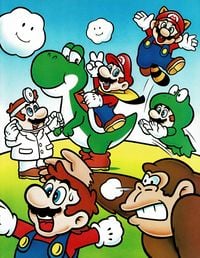
The Mario series is the largest video game franchise in existence, and has had a lifespan of over thirty years. It is often considered to be the greatest video game series of all time, receiving many high-scoring reviews on their various games.[13] It is also the best-selling video game franchise in history; the games in the core series, alone, have sold a combined total of over 262 million copies.[14] In the series, many games have been considered to be the best of their time by players.[15] However, the series has been considered to have some games of lower quality.[16] An example is the Mario Party sub-series; after the release of Mario Party 3, the series is considered to have lost its flair, as the games often contain the same mechanics.[17] Super Mario Bros. was declared to be the greatest video game of all time twice: once by GamesRadar in 2000, and another time by IGN in 2003.[18]
The Mario cartoons also were shown to have received favorable reviews.[19][20][21] Though each of the series were short-lived, they were considered to be highly popular, attracting an audience of children to each episode.[22]
Even with the success of the games and cartoons in the series, there was still a large production that attracted a lot of negative reviews. The Super Mario Bros. film is often considered to be a great failure. The film took over a $20 million gross loss in profits. Bob Hoskins, who played the role of Mario in the film, was recorded saying that the movie was a "nightmare". In the May 2006 issue of Nintendo Power, an interviewer from the magazine had said, "Yes, it happened. Let us speak no more of it." The video game Hotel Mario has often been cited as one of the worst games ever.
Cultural impact
The Mario series has been referenced many ways throughout the years. From animation to music, and from the internet to other video games, the Mario series has culturally impacted many people.
In animation, Mario characters and elements have appeared in such shows as The Simpsons, The Ren and Stimpy Show, The Fairly OddParents and Mad twice.
In films, the Mario series has been referenced in such titles as Billy Madison and Ghostbusters II.
Not many references have been made to the Mario series in music, but some songs have been dedicated to the popular series, such as the song "Birdo" as performed by Horse the Band.
The Mario series is highly popular on the internet. Many websites have dedicated themselves to the series in some way, while others poke fun at the series. On YouTube, there are thousands of videos poking fun at one of the greatest blunders of the Mario series, Hotel Mario. The popular website, Newgrounds, has many fan-made games and videos, like the popular Super Mario Bros. Z, Super Smash Bros. ST and The 1-up Pursuit, that are Mario-themed in some way.
Many comics and books have also referenced the Mario series, or are completely centered around them.
In television, the Mario series has been referenced in such shows as The Fresh Prince of Bel-Air and My Name is Earl.
The Mario series has been referenced more times in video games than in any other form of publication. Many games created by Nintendo, such as Animal Crossing make very notable references to the Mario series. Even games on non-Nintendo consoles, such as Banjo-Kazooie: Nuts & Bolts, have referenced the Mario series in some way.
The Mario series has also been referenced in commercials as well as other theatrical productions.
References
- ^ UGO's "Top 11 Video Game Power-Ups" List
- ^ Best-selling NES game
- ^ Extreme difficulty of Super Mario Bros.: The Lost Levels
- ^ Super Mario Land's sales total
- ^ Mario Land 2 sales
- ^ Super Mario RPG: Legend of the Seven Stars user ratings
- ^ Super Mario 64 sales results
- ^ Rumored glitches in Super Mario 64
- ^ Rumors of Luigi in Super Mario 64
- ^ Super Mario Bros. Deluxe sales
- ^ Official Nintendo Magazine (Great Britain) January 2010, pg. 62
- ^ Big N Magazine. p.19. July-August 2000.
- ^ Critical acclaim (from IGN)
- ^ Mario Games Go Red
- ^ 100 games — 7 of which are Mario games
- ^ 10 Biggest Video Game Flops — GamePro
- ^ Mario Party series ratings
- ^ Super Mario Bros. declared the greatest game of all time
- ^ Review of The Super Mario Bros. Super Show!
- ^ Review of The Adventures of Super Mario Bros. 3
- ^ Review for the Super Mario World animated series
- ^ The cartoons that had children waiting for more of the Mushroom Kingdom

